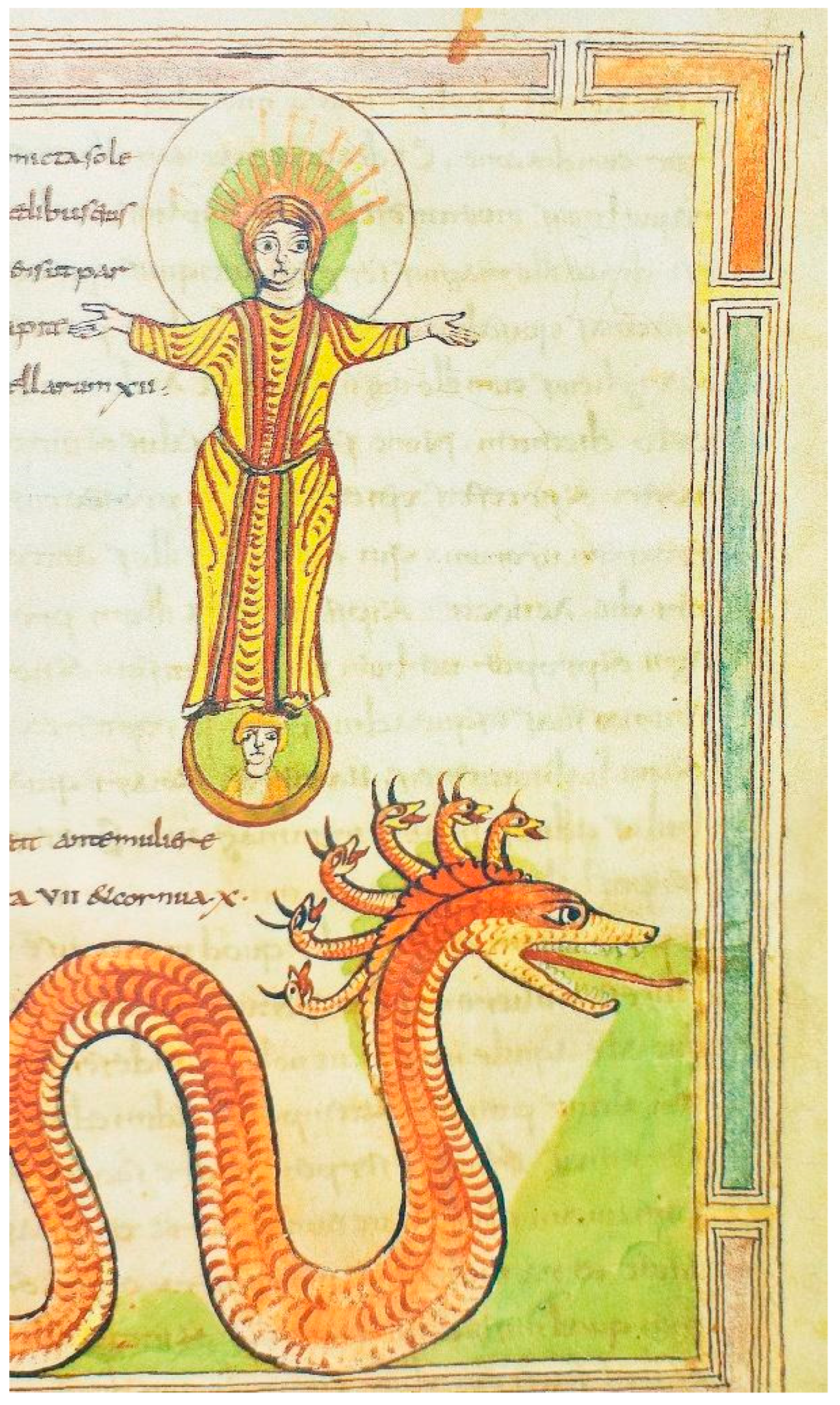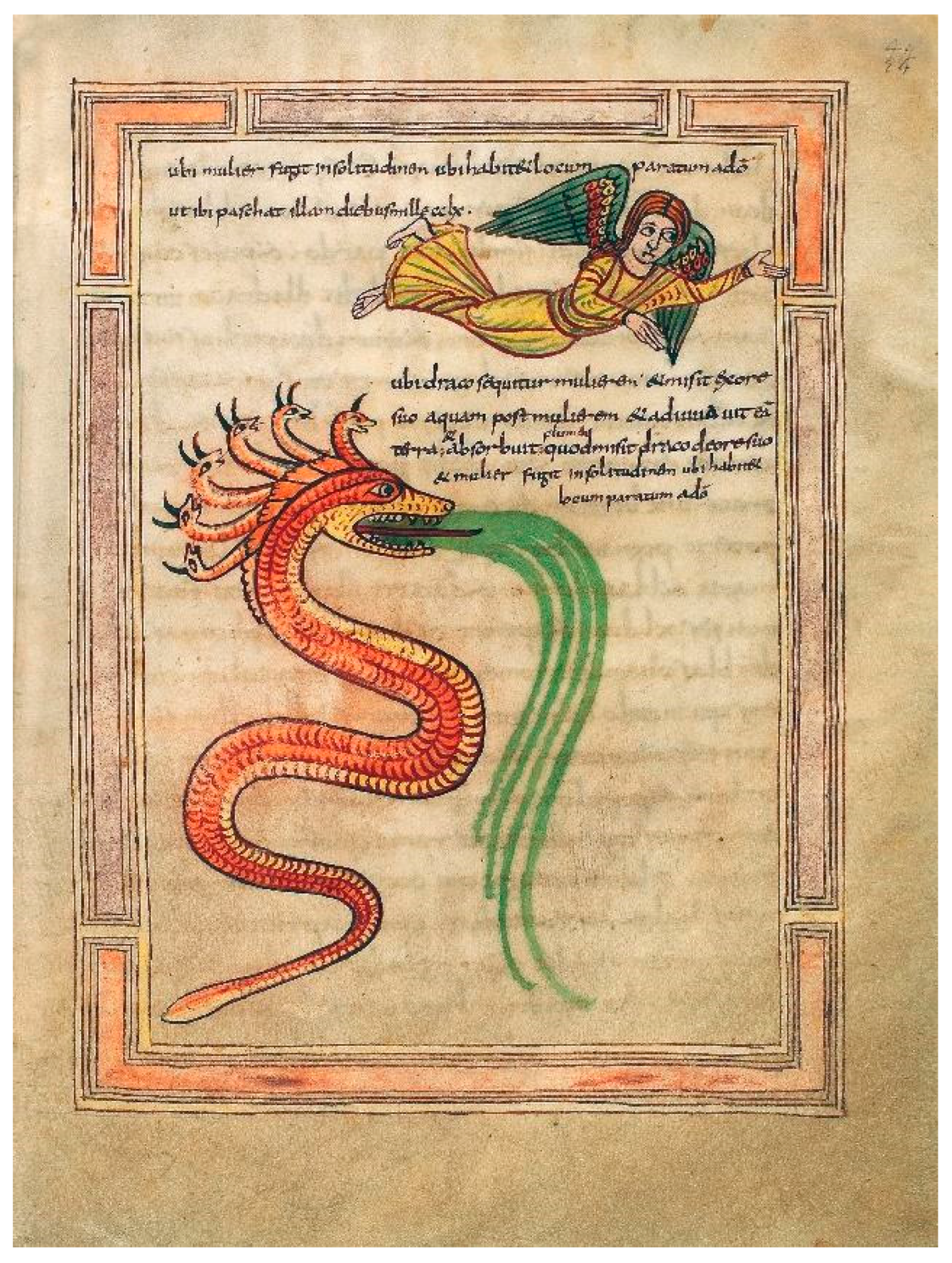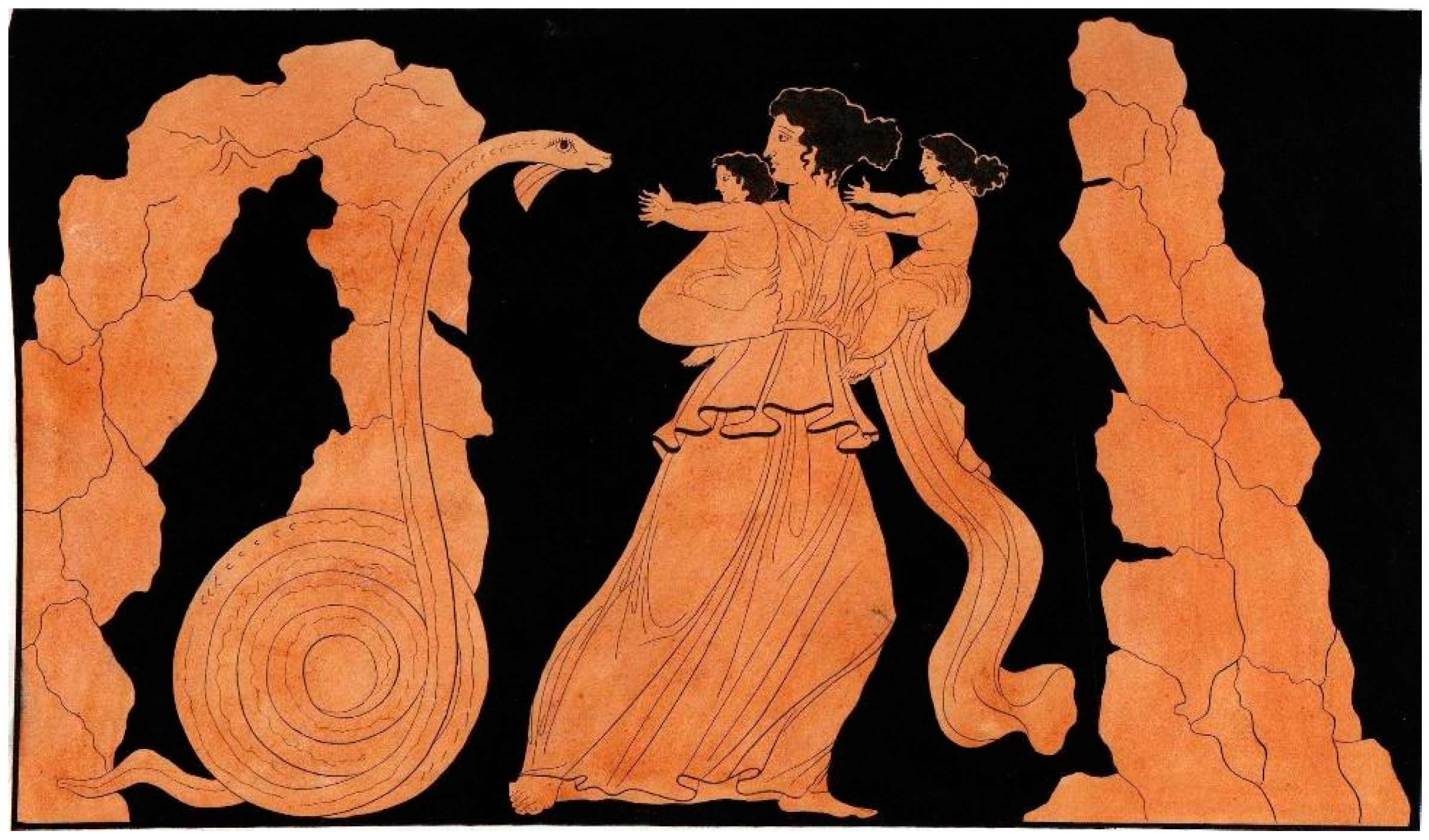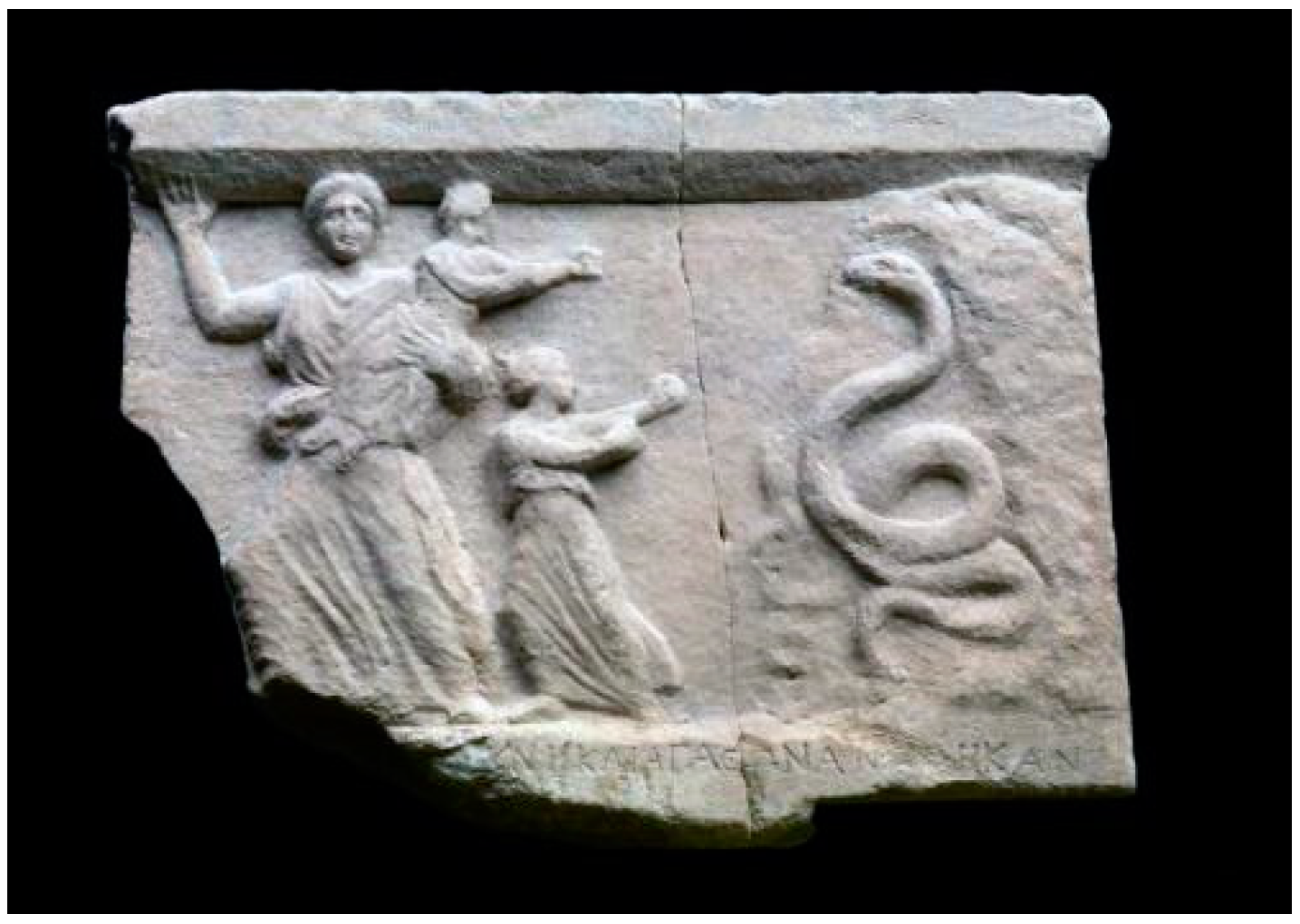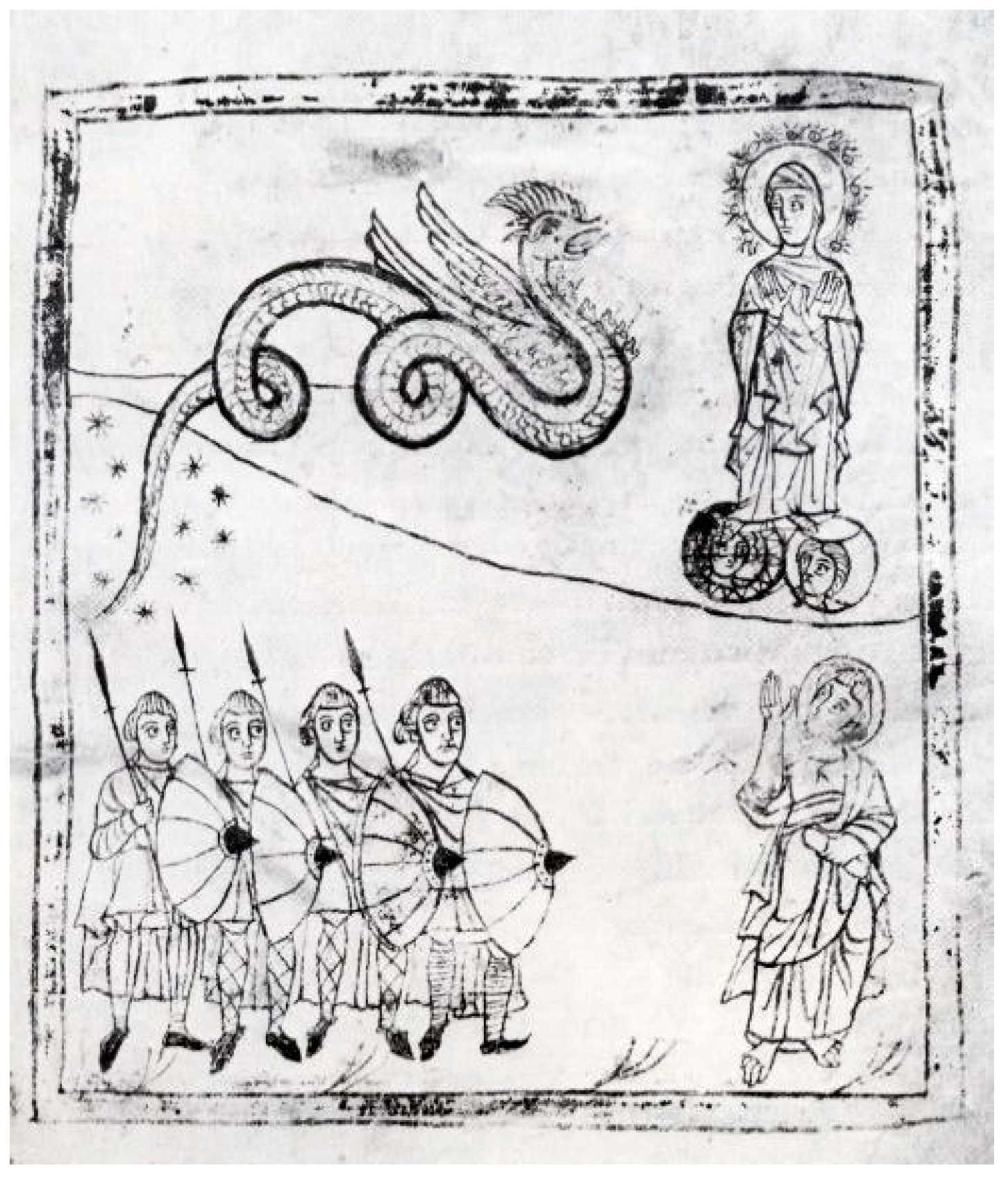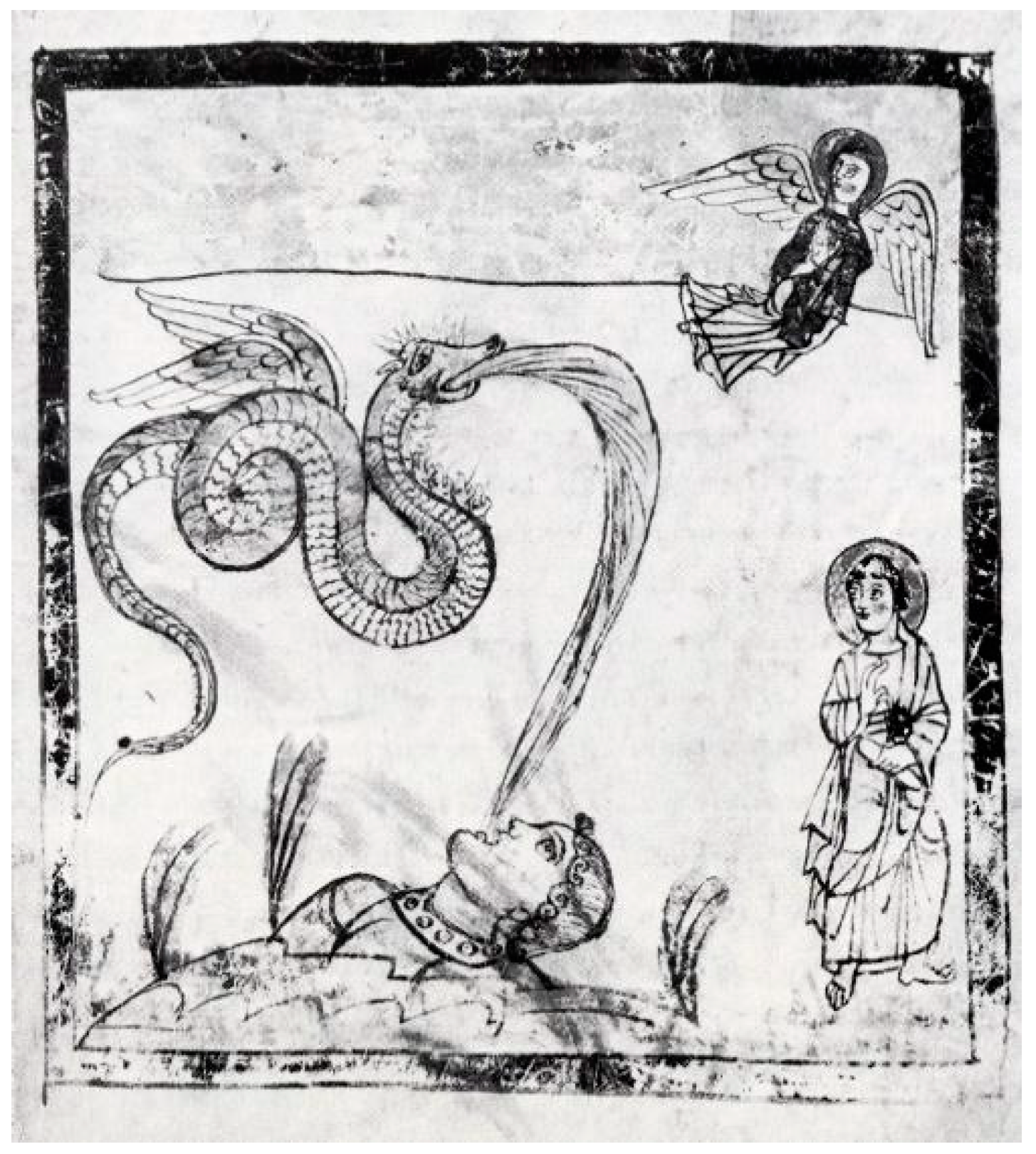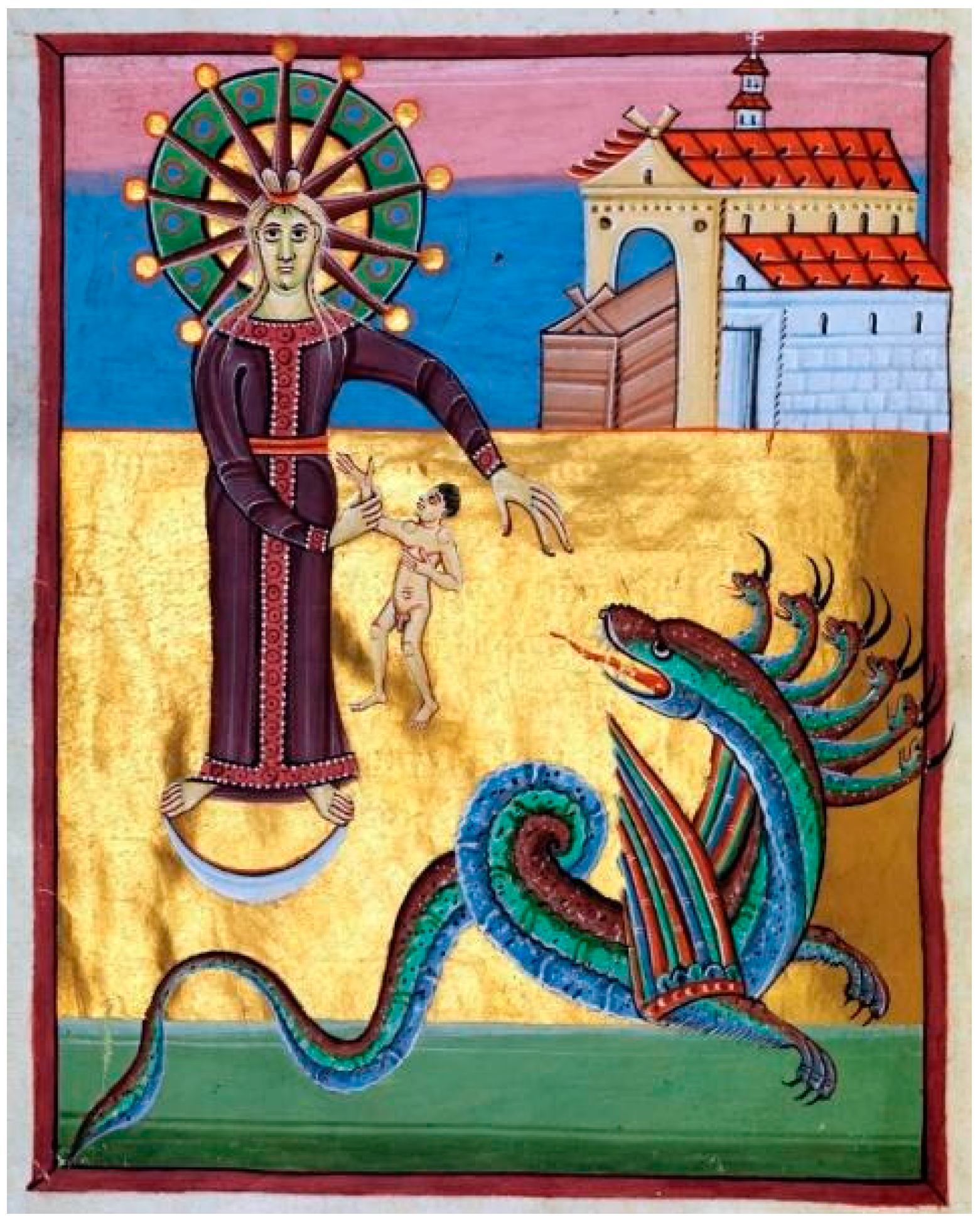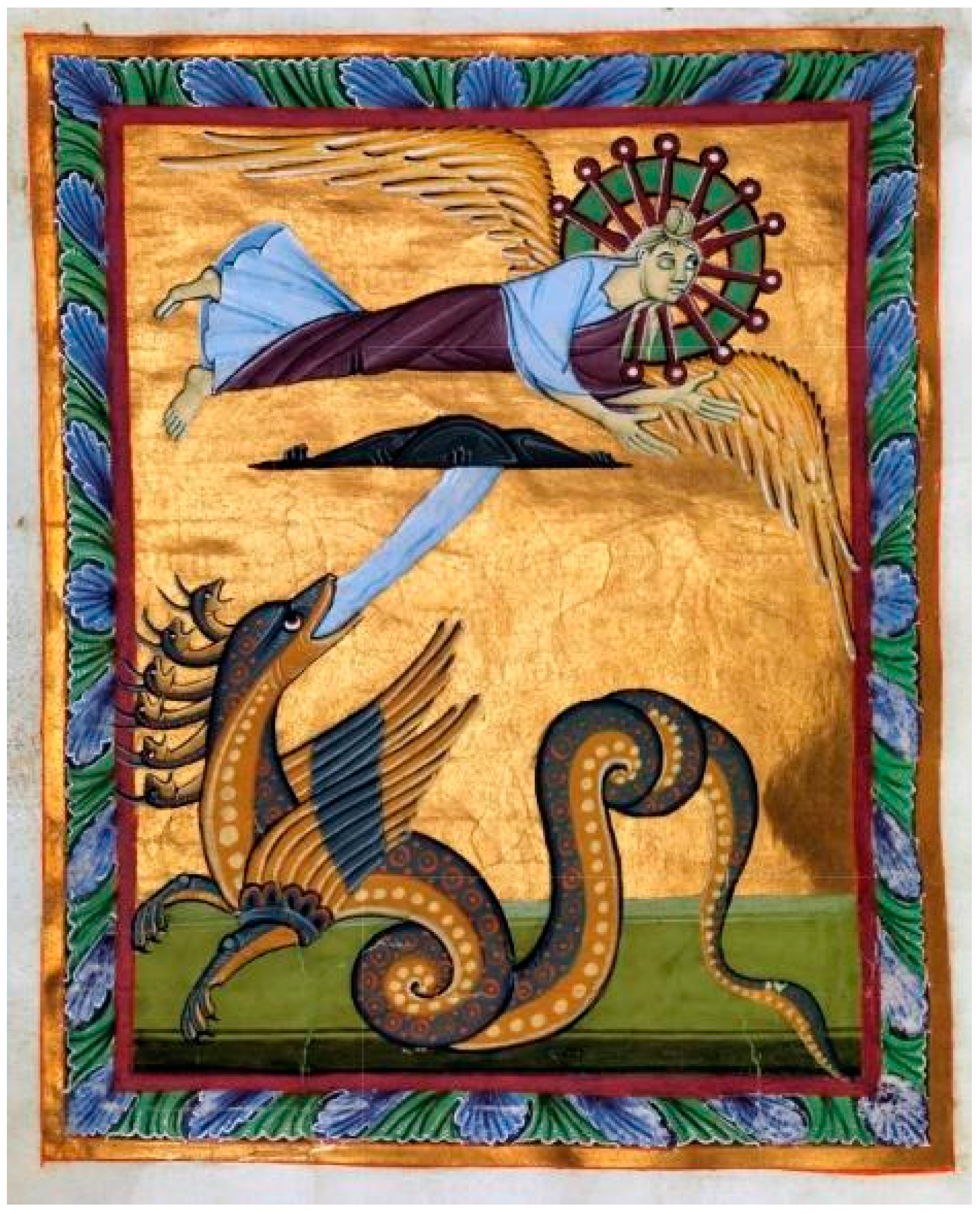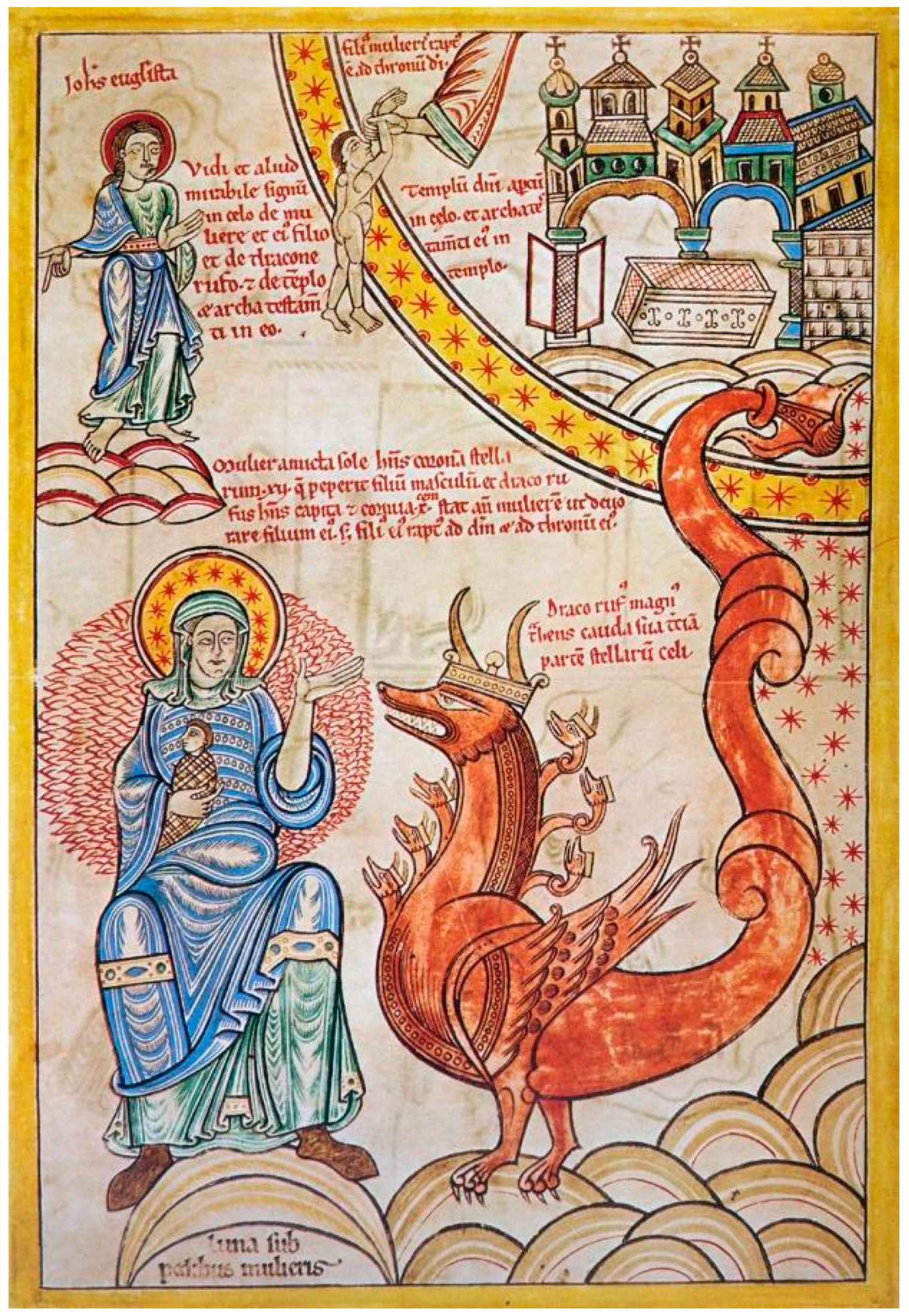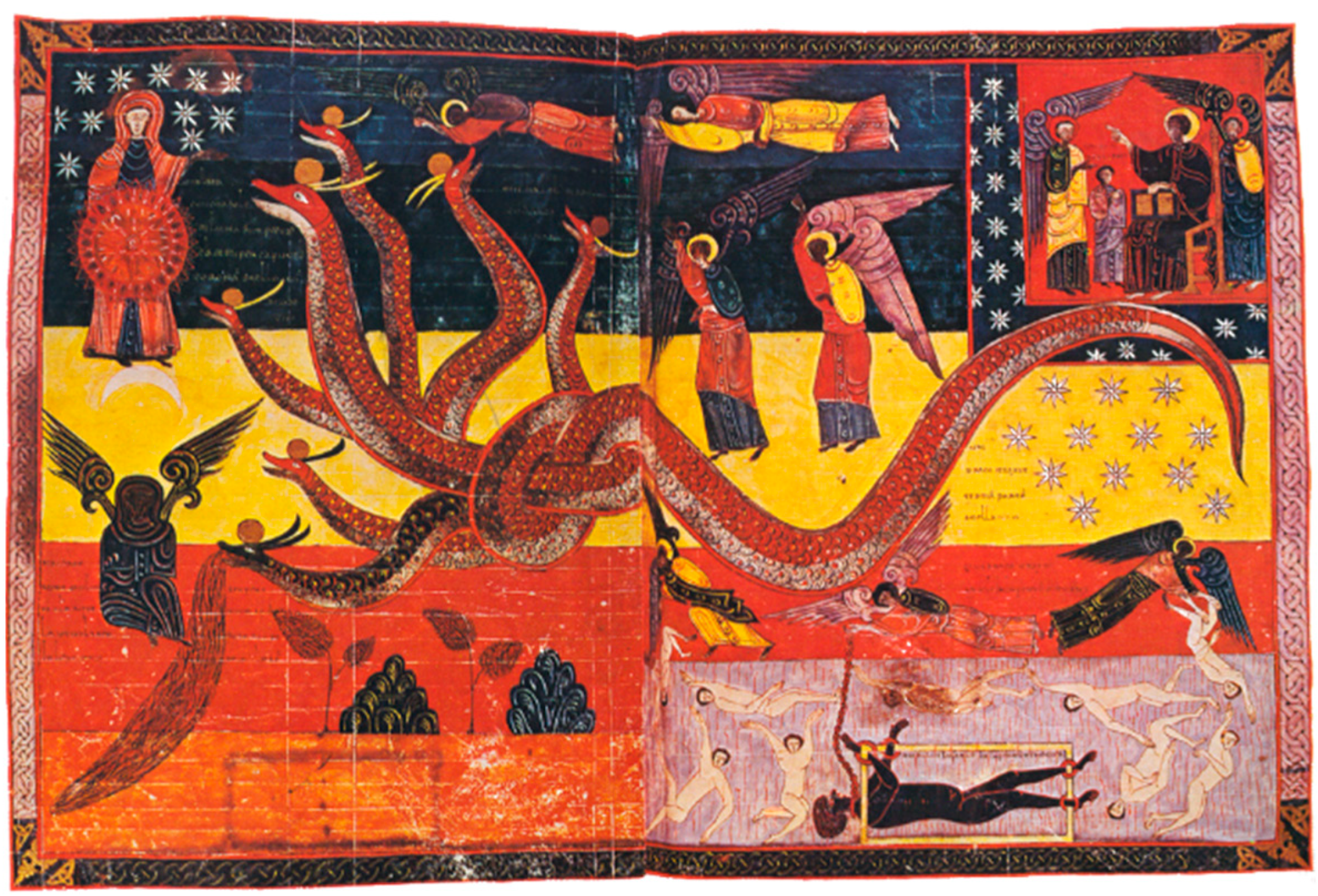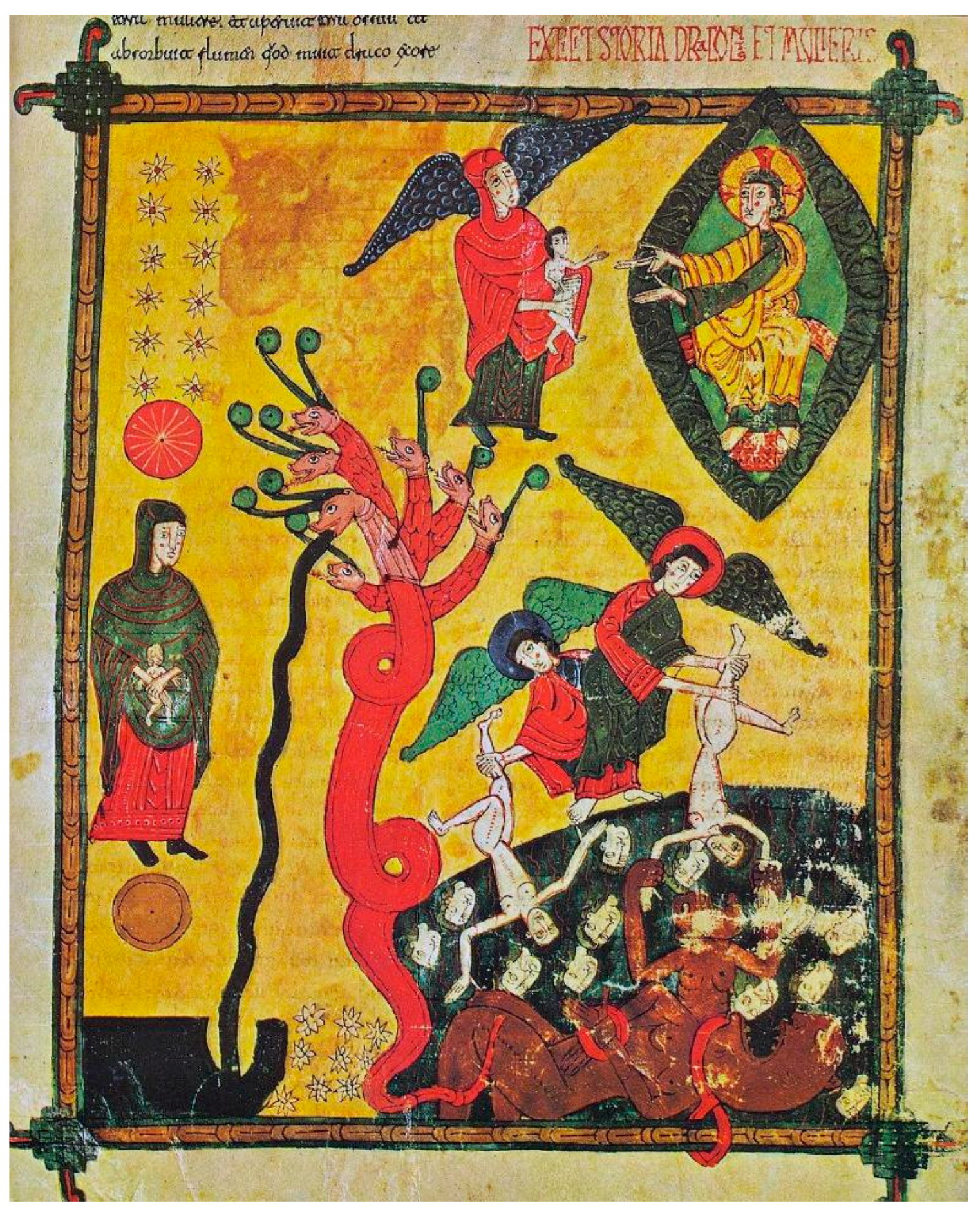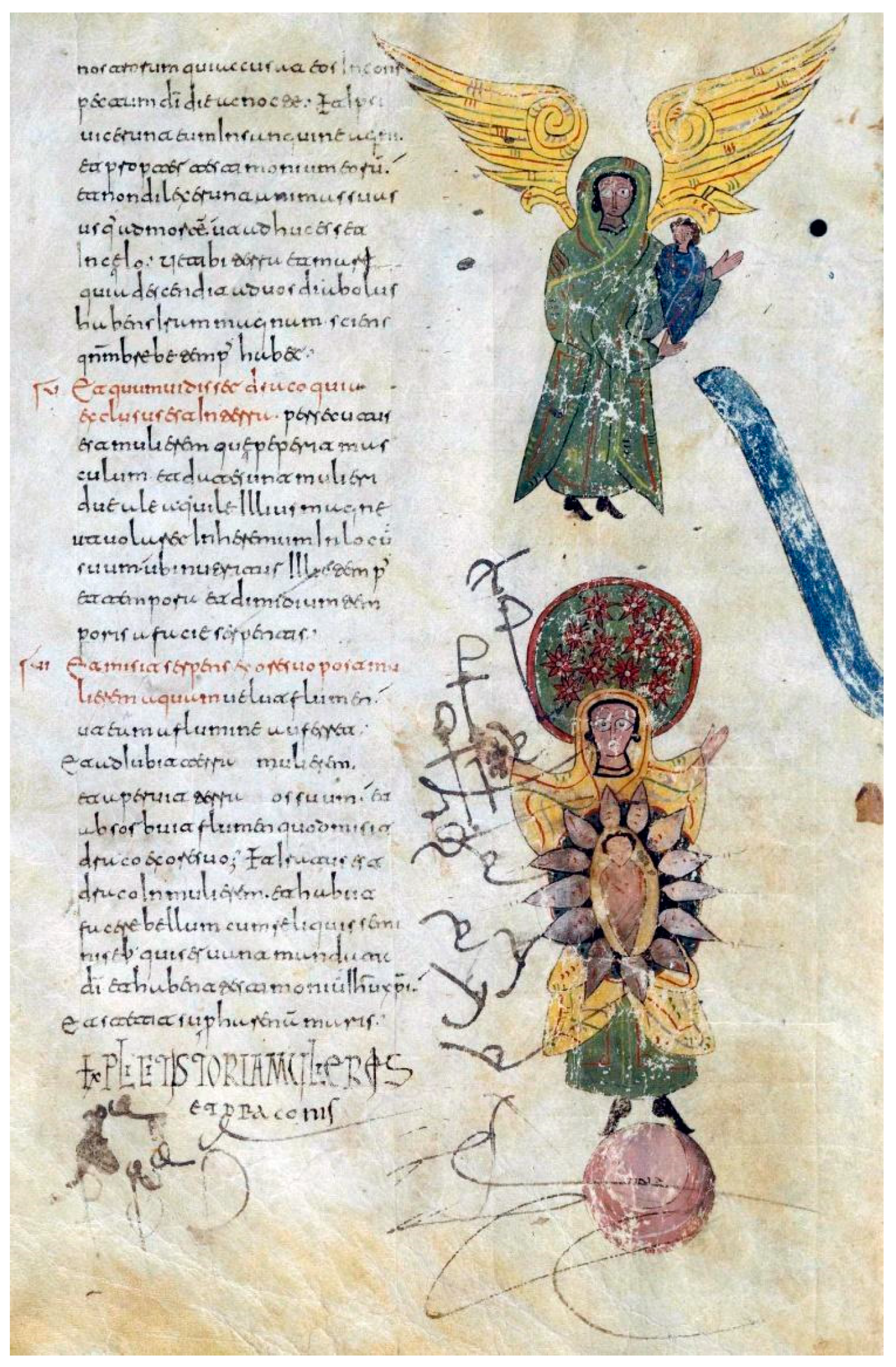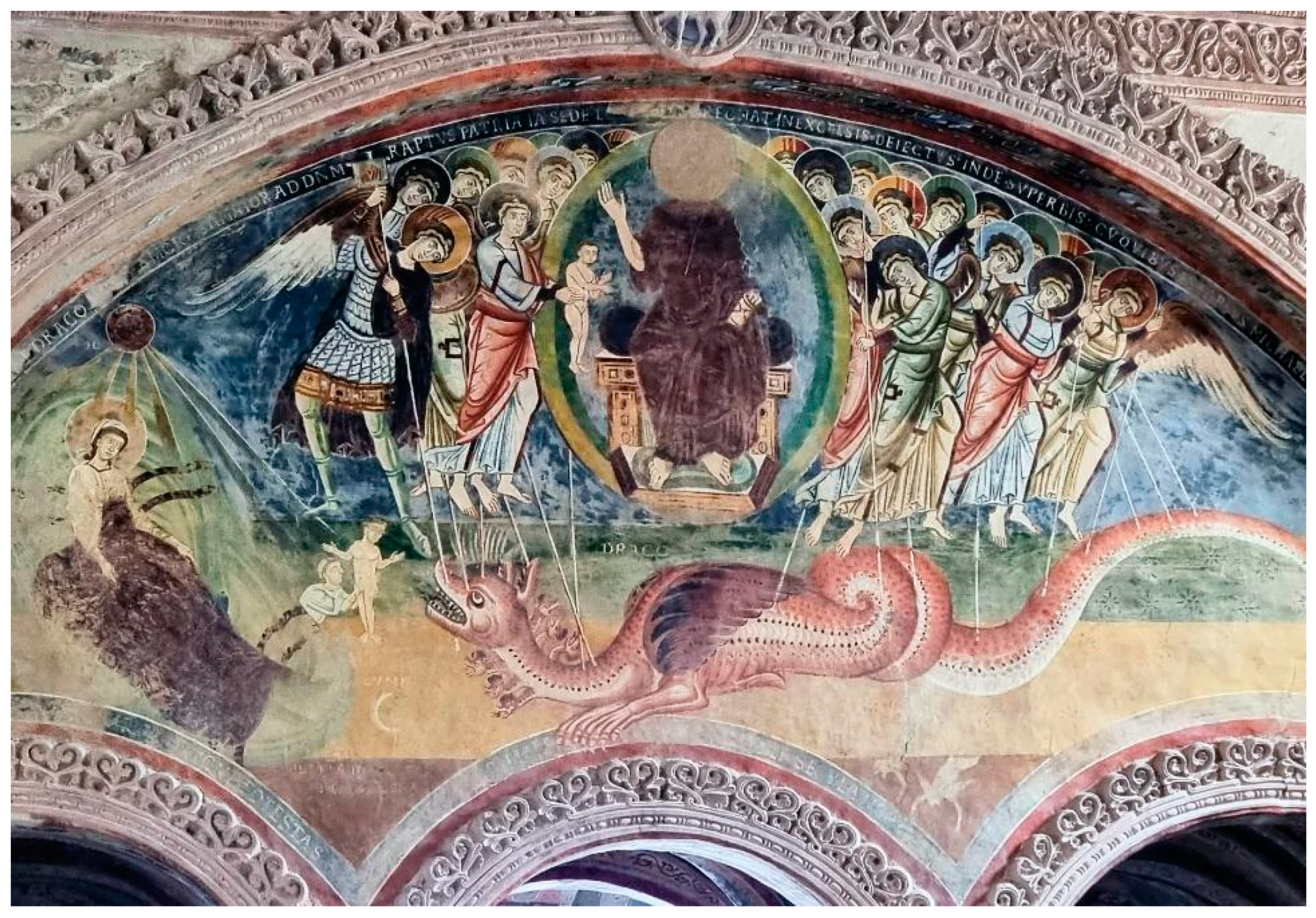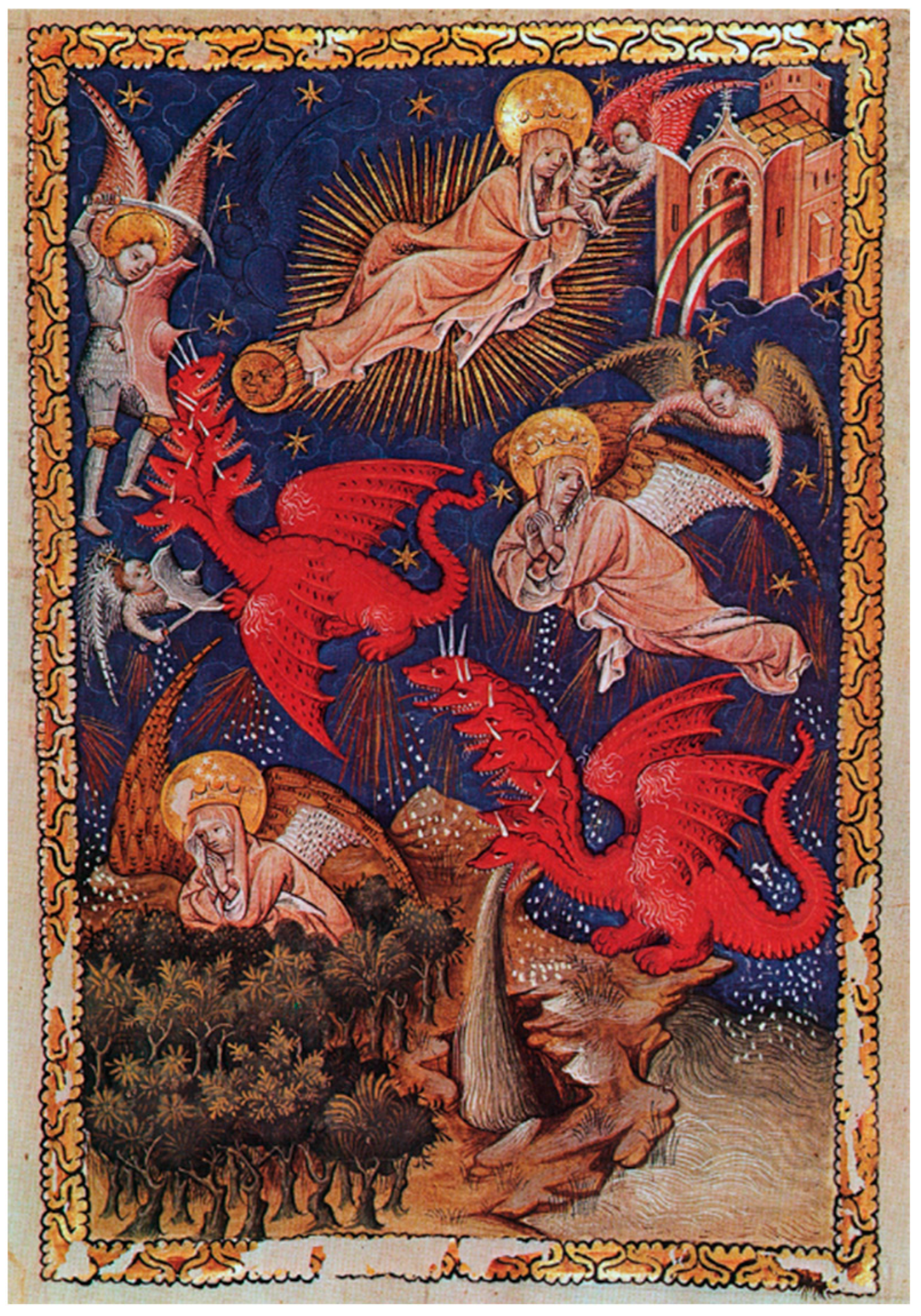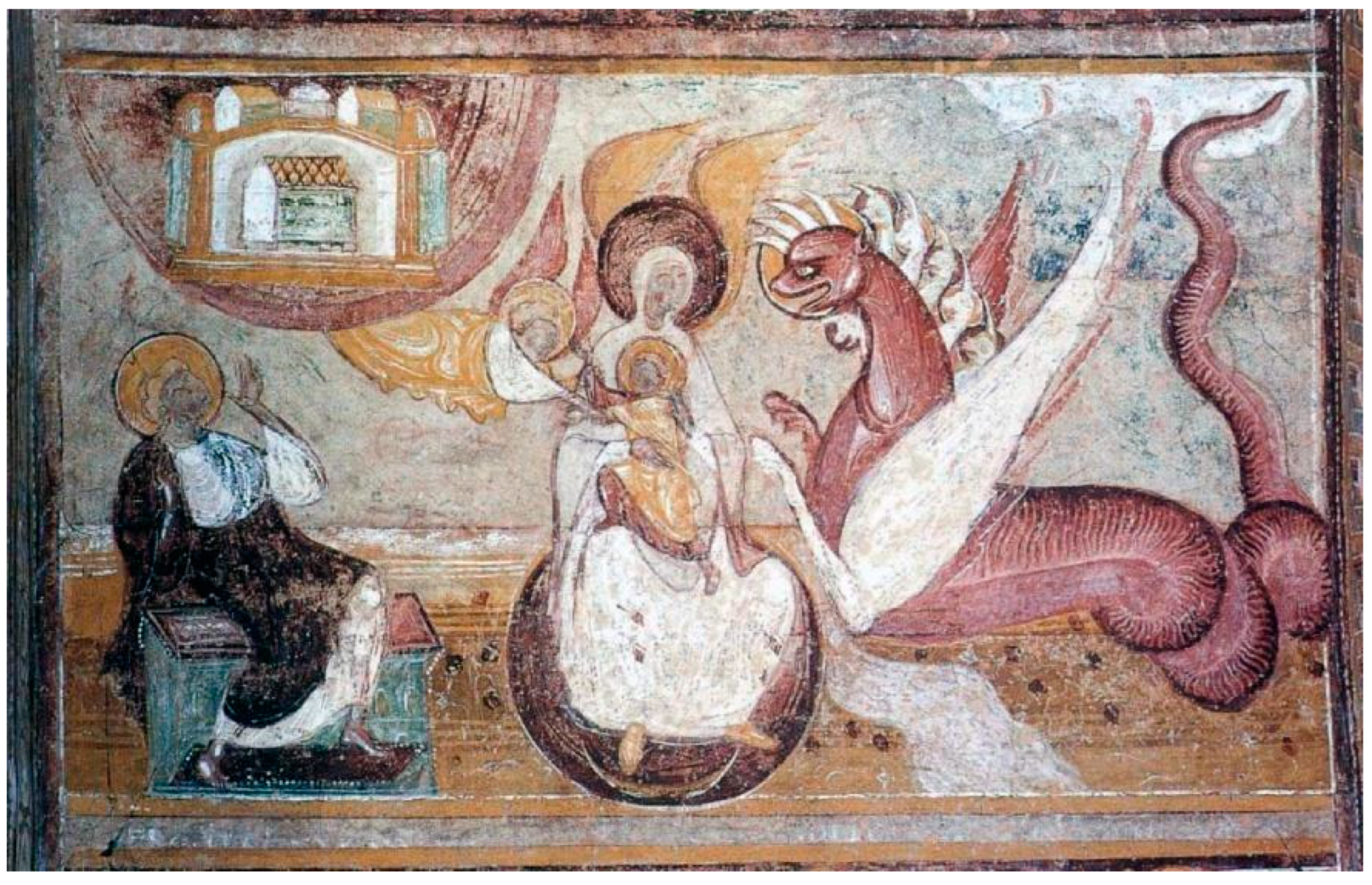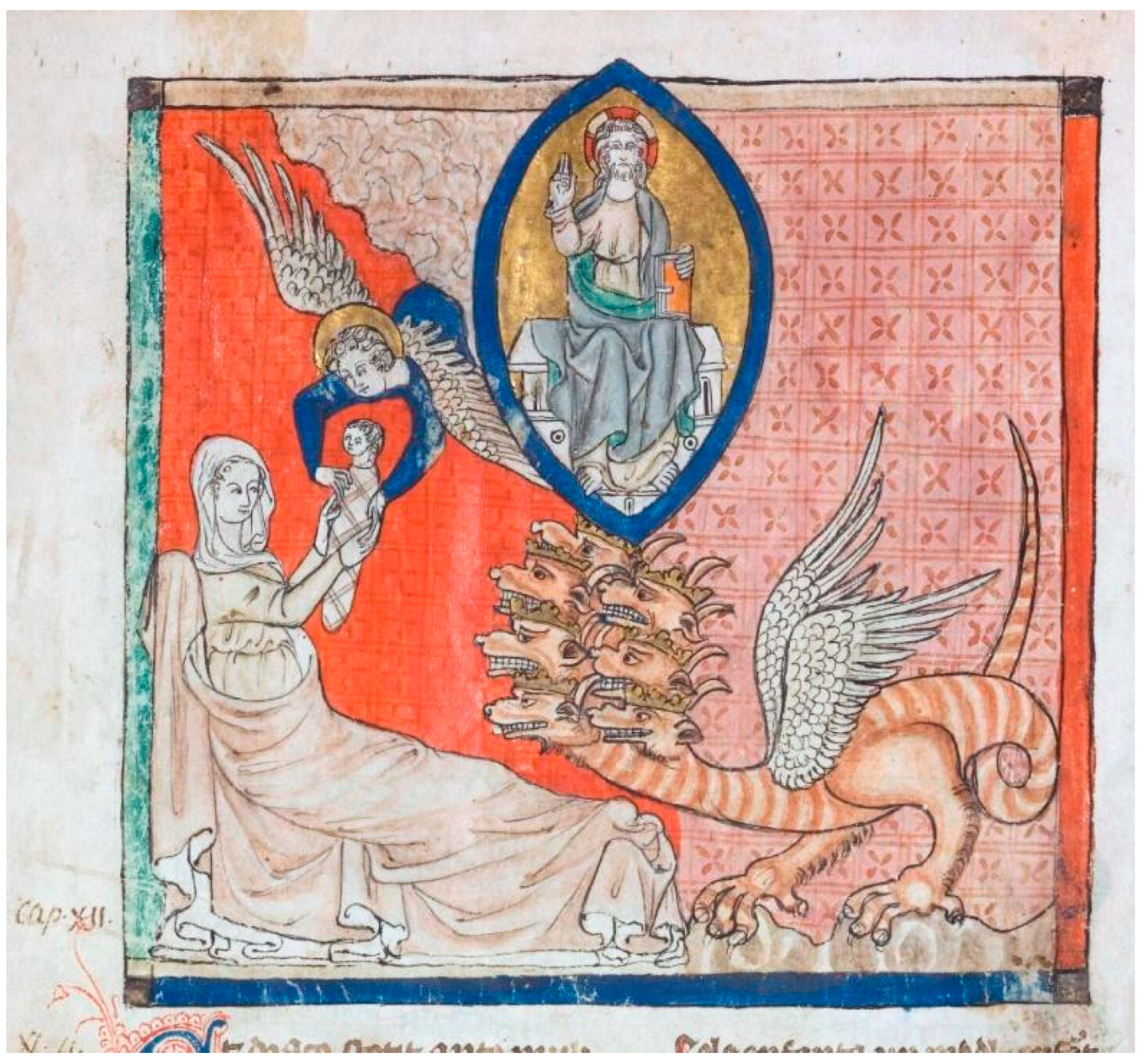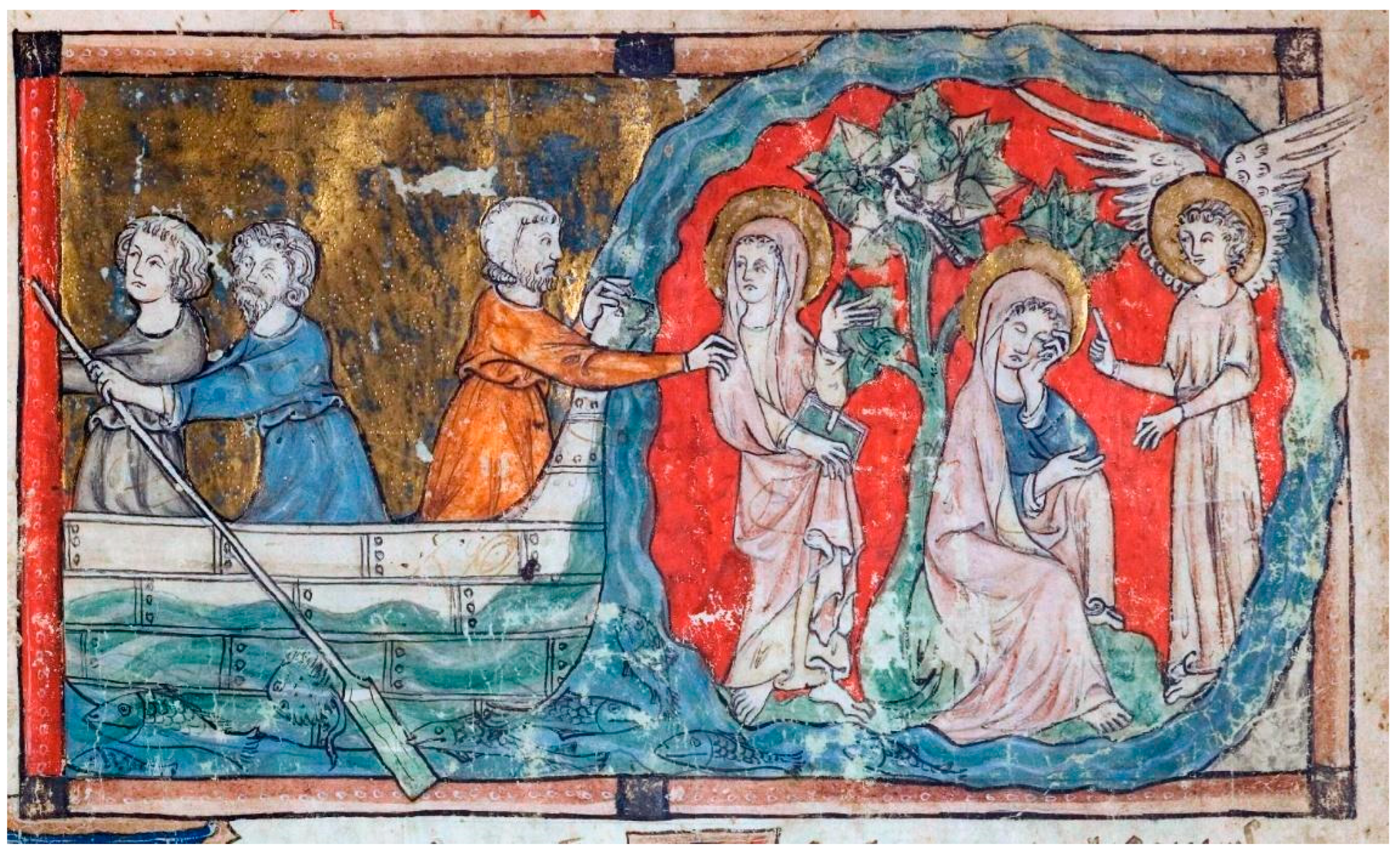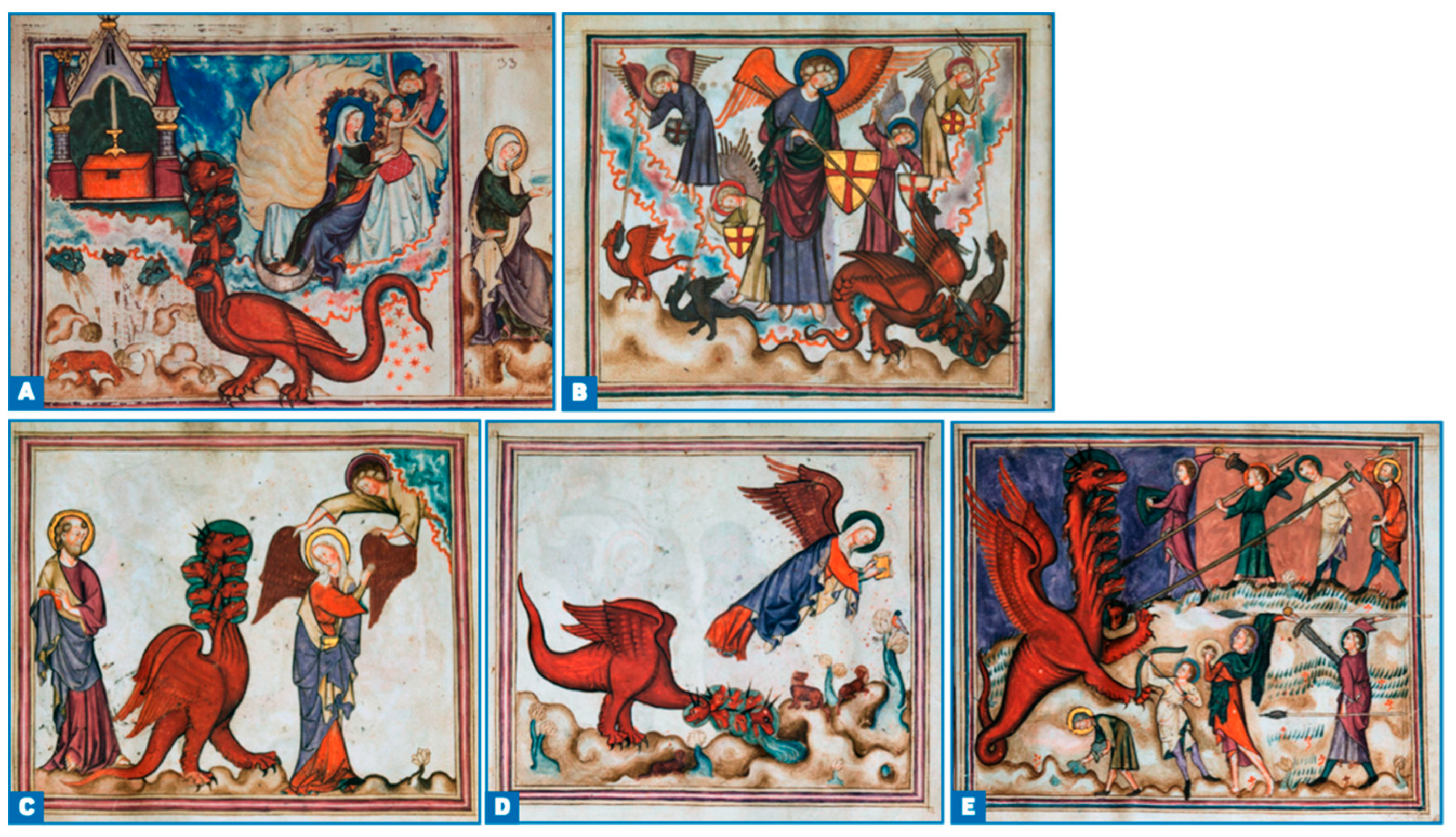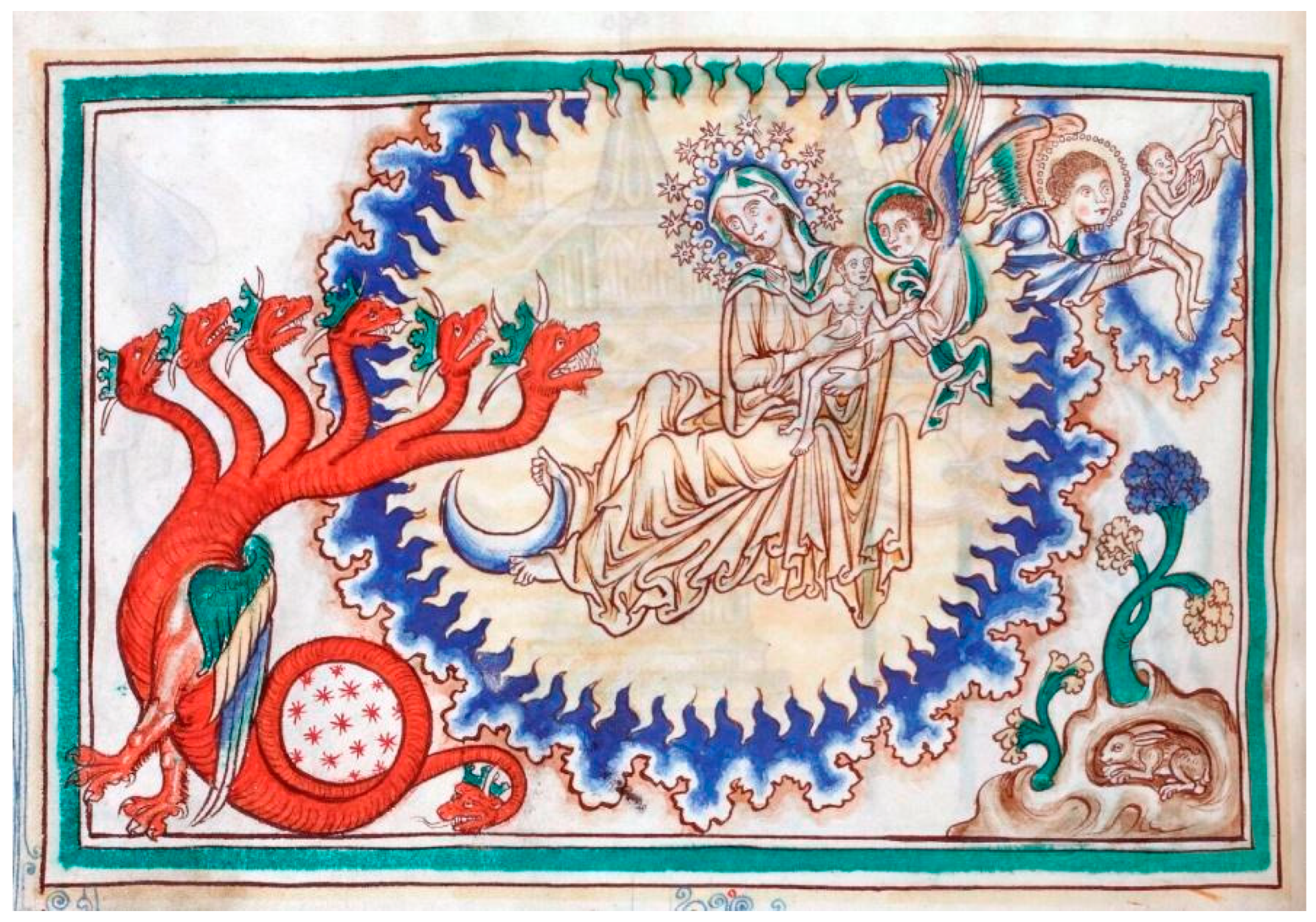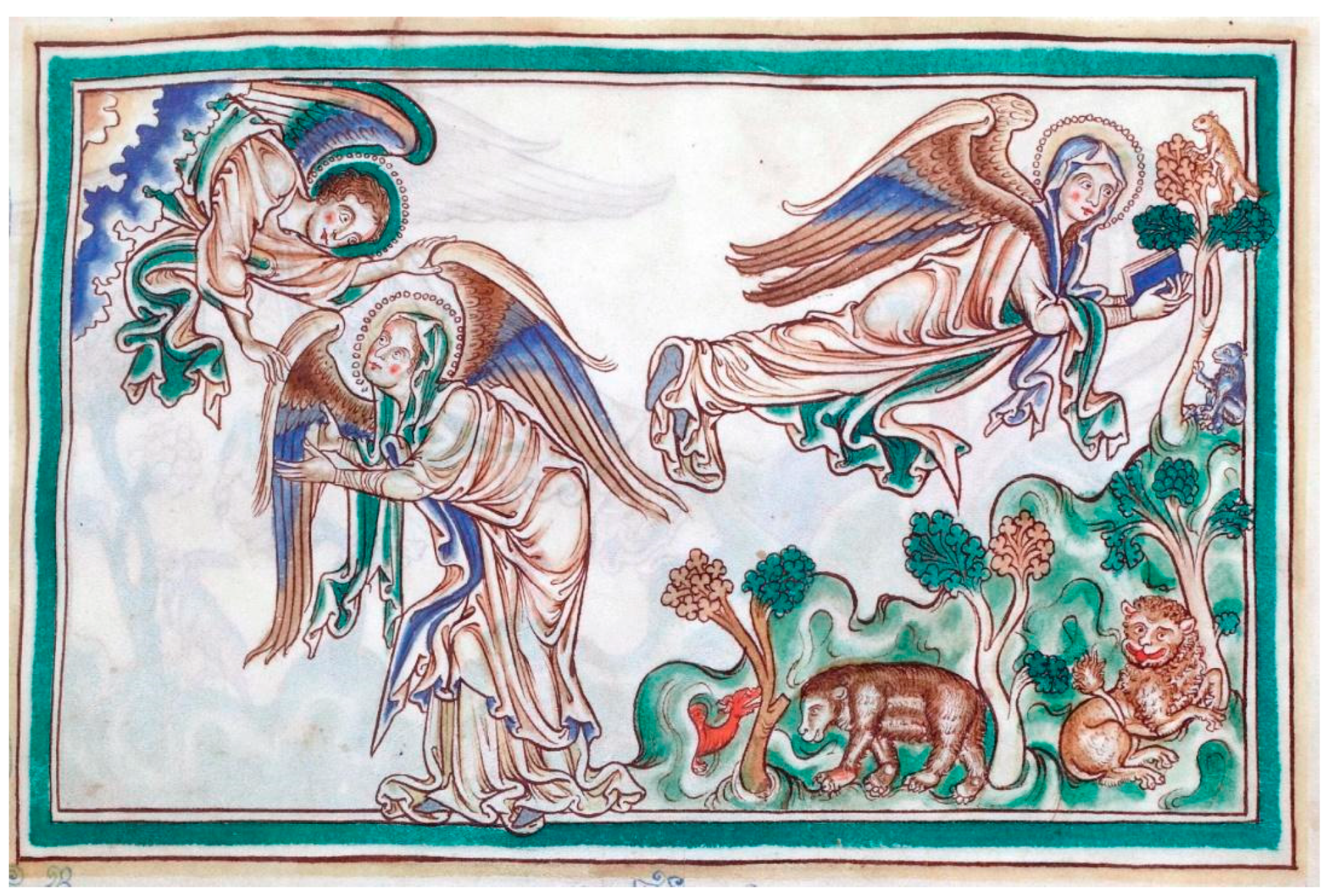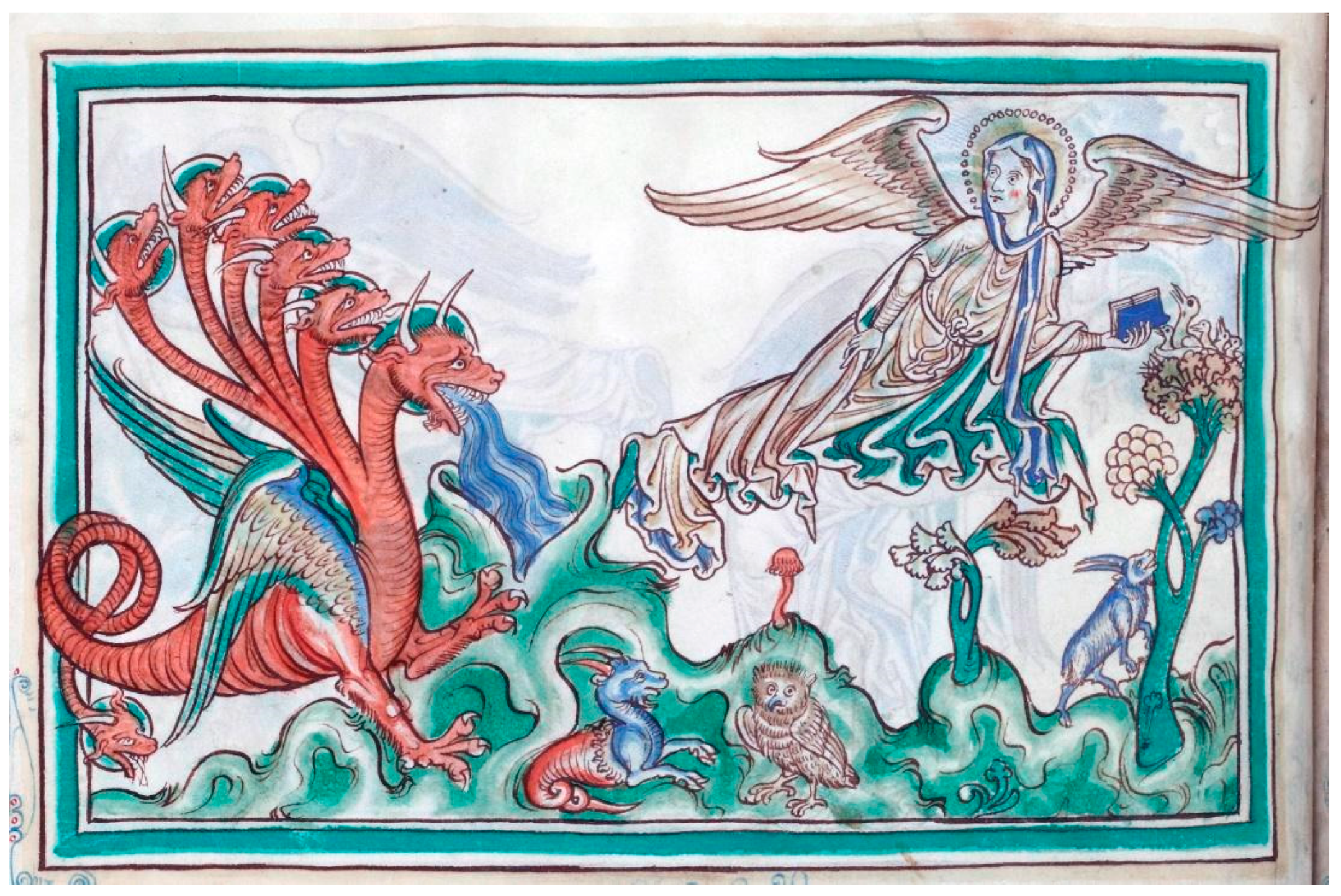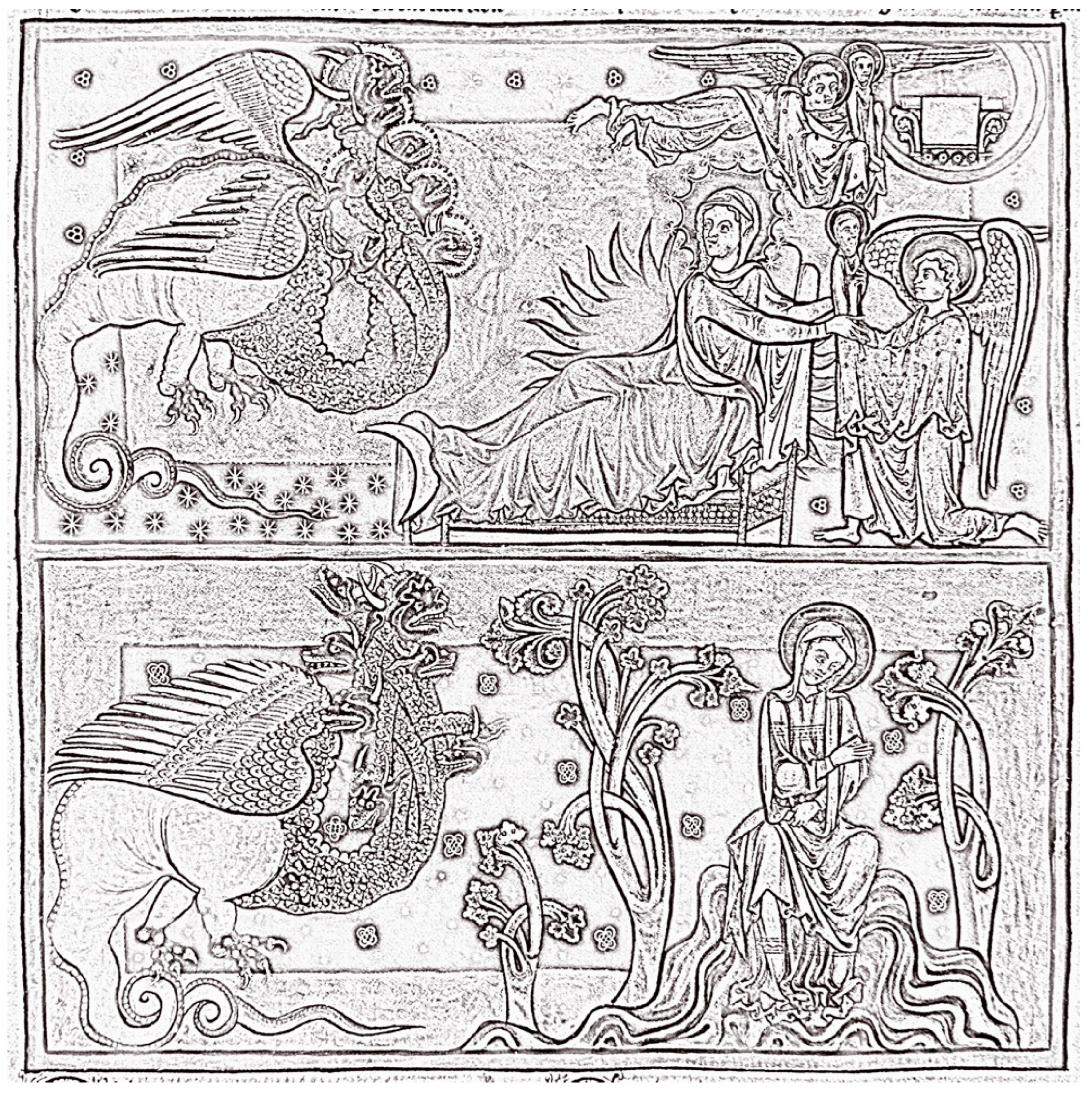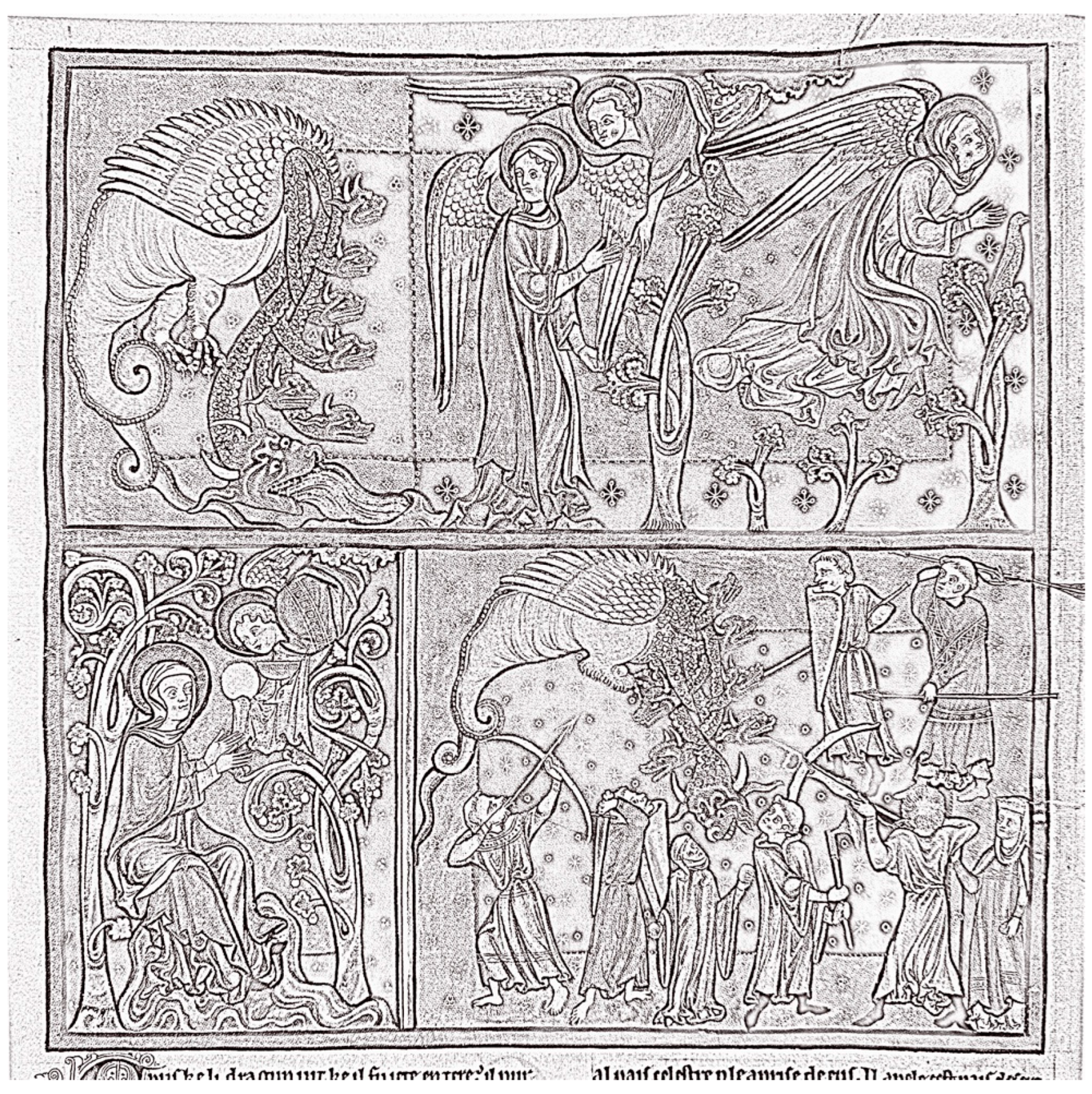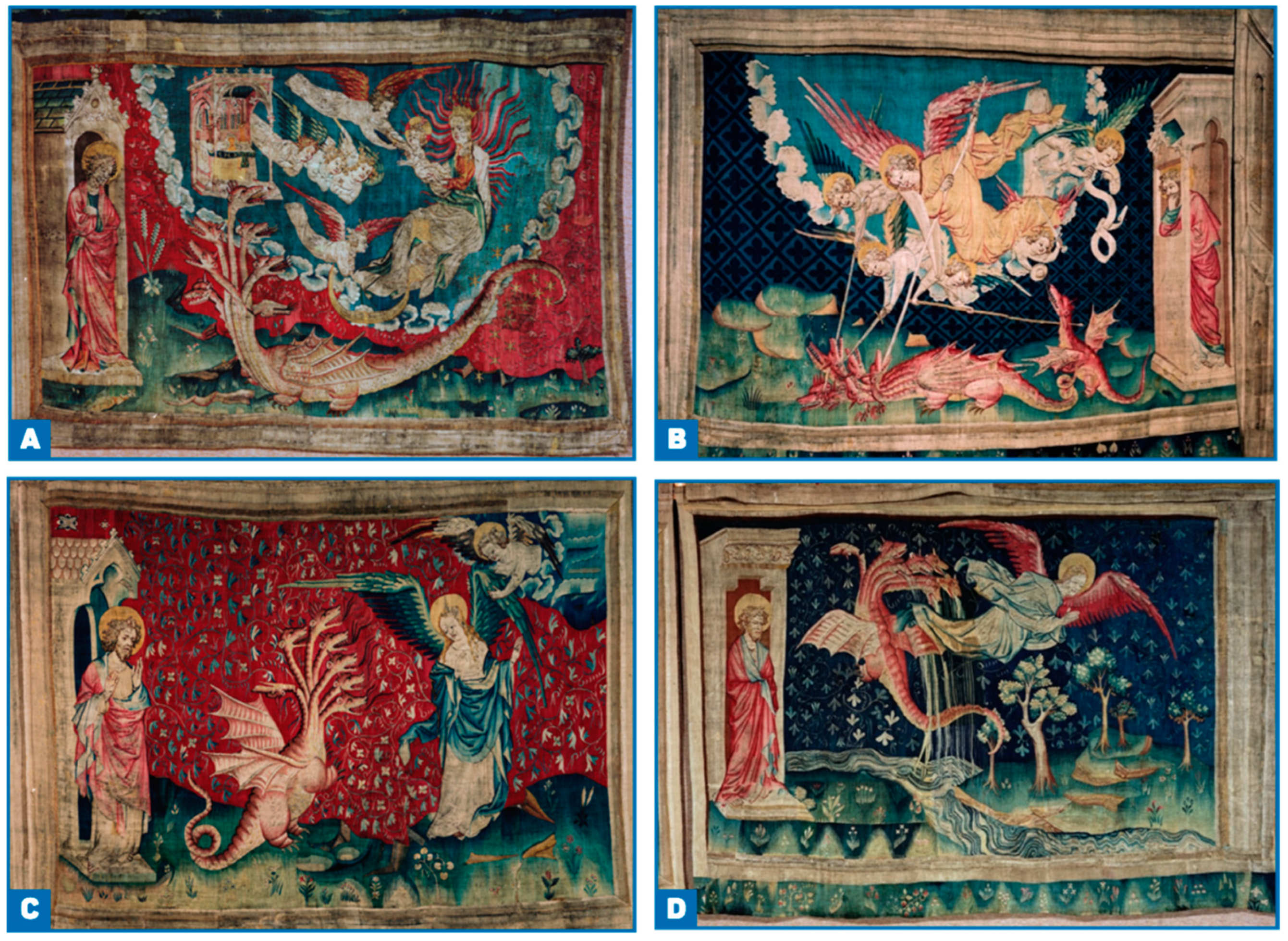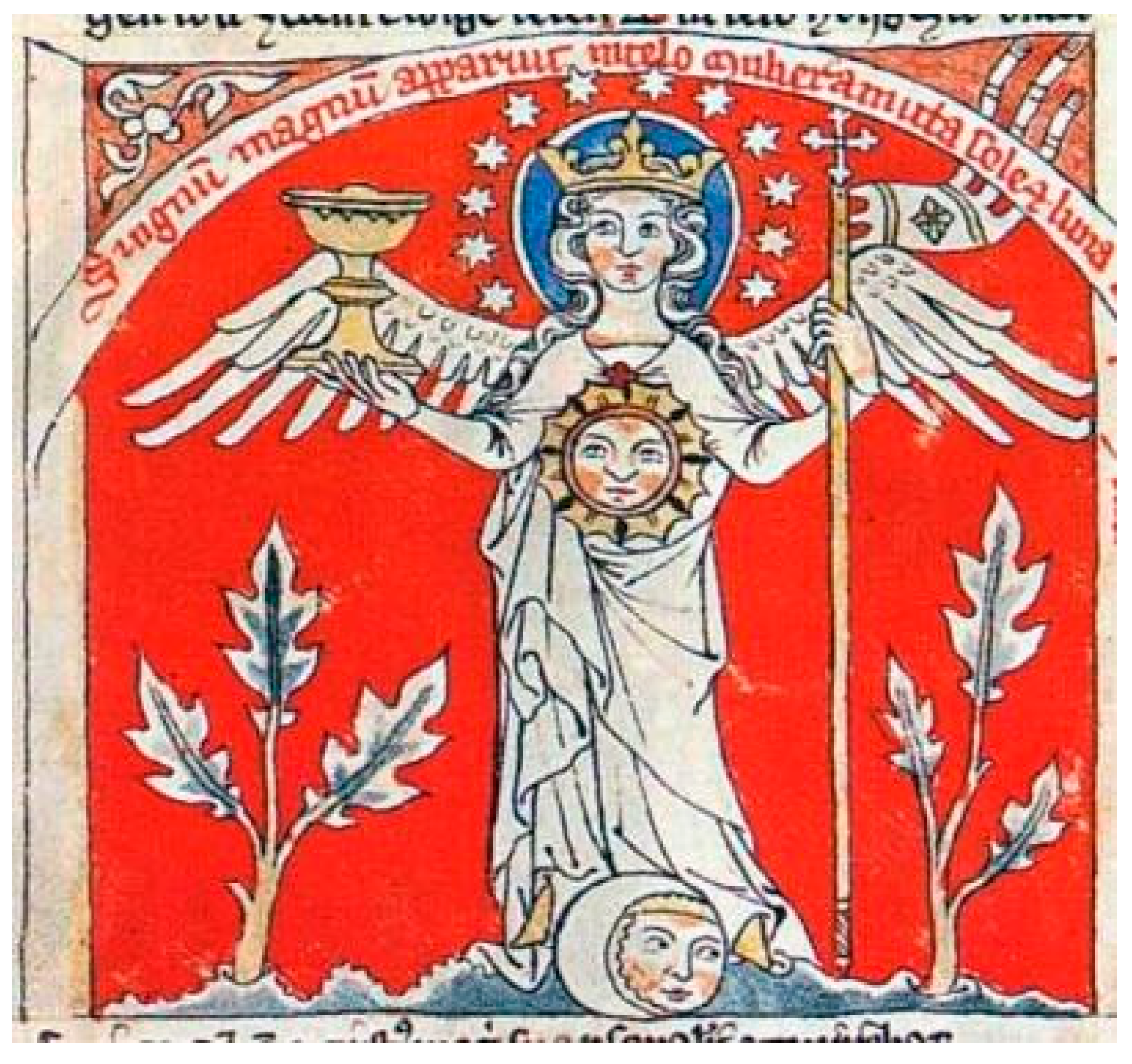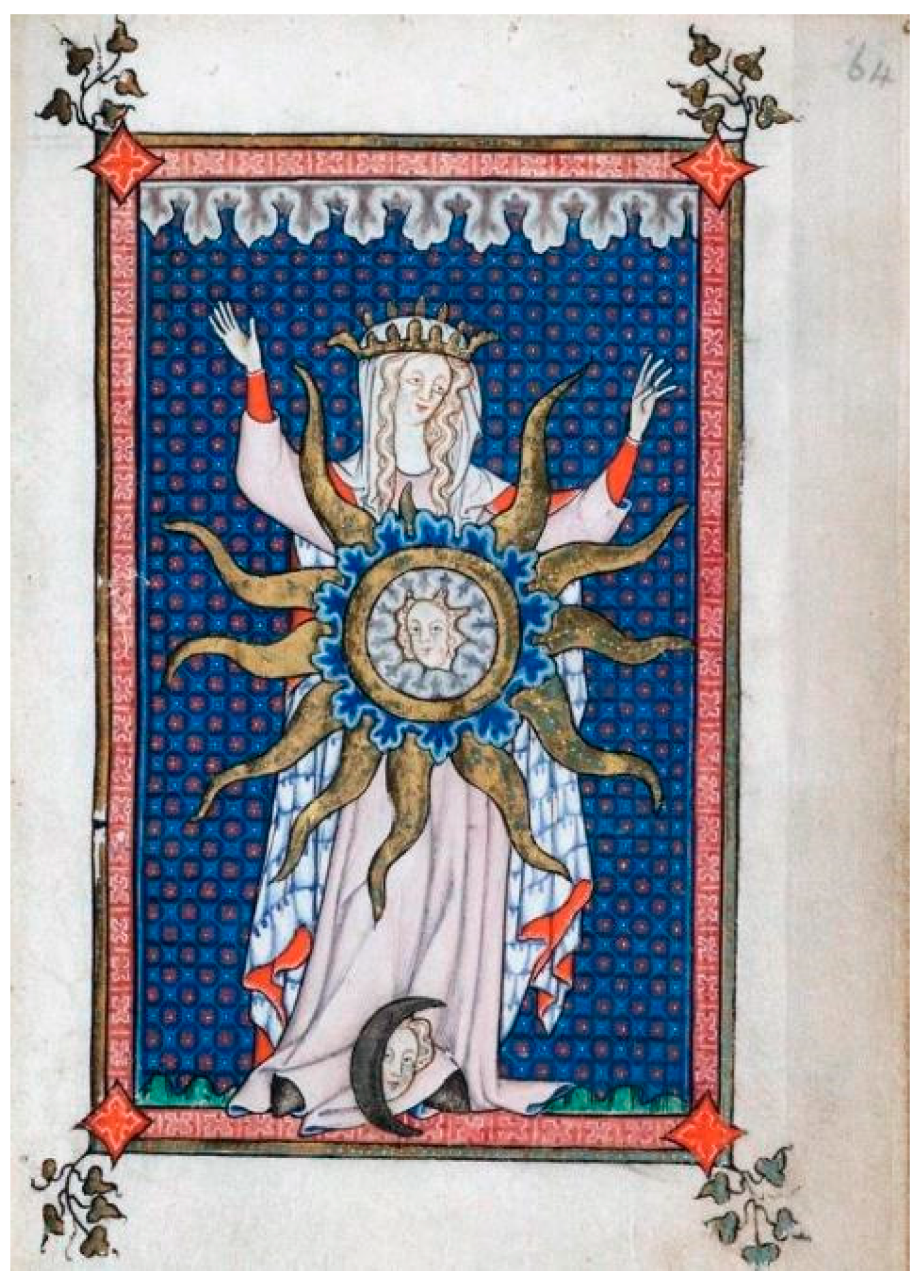3. The Formation of the Iconographic Type of the Mulier Amicta Sole—The Earliest Families of Italian and French of Illuminated Manuscripts of Revelation and the Beatus (Ninth to Twelfth Centuries)
Here we find one of the few themes in Christian iconography whose original typology owes little to Byzantine art. The use of images inspired by Revelation and linked to triumphant visions of theophany began in Rome from the “Little Peace” of the Church at the beginning of the fourth century. However, only depictions of symbols such as alpha and omega are used. It is probable that the first illustrations of the book in which the different narrative cycles appear were produced towards the middle of the fourth or in the early fifth century and their composition owes much to the ancient past. The image of the Woman Clothed with the Sun appears at this time, although the first examples preserved to this day of the representation of this theme date back to the ninth century. In these early preserved medieval representations of the mulier, two modalities or families are found. On the one hand, the miniatures of the Italian and French tradition and, on the other hand, the illustrations of the Beatus.
The illustrations of the first illuminated books of Revelation have not survived, but we can state that their composition must have formally responded to the ancient way of illustrating codices, inserting the vignettes or panels with images in the text framed in red boxes, coinciding exactly with where the content represented is mentioned. They were works that presented a narrative sense and that therefore still lacked development with the intention of highlighting the symbolic aspects. Although we do not have direct evidence, we find echoes of these in works of the Italian and French tradition that emerged as copies of the first models. It is this prototype that is followed by manuscripts such as the
Apocalypse of Valenciennes (
Figure 1), from the first third of the ninth century, or the manuscript of Trier, a Carolingian copy from the early ninth century of a model from the late fourth century or early fifth century (
Figure 2).
As for the formation of the various iconographic types that make up the theme of the Woman Clothed with the Sun, it is noted that together they formed a cyclical theme. There is a common feature in these early medieval images of the Woman of the Apocalypse that would be continued in later works, even those that accompanied Beatus of Liebana’s commentary. It is the division of chapter 12 of Revelation into three episodes that correspond to three initial iconographic types. On the one hand, we have the mulier amicta sole with the astrological symbols and the dragon that pursues her (Rev 12, pp. 1–6). This episode followed by the struggle between Michael and the dragon (Rev 12, pp. 7–12). Finally, the Woman who has already been given the “two wings of the great eagle” [duale alae aquilae magnae] is shown, and the dragon pursues her by pouring out a river of water that is swallowed by the earth (Rev 12, pp. 13–17). Each of the scenes is represented separately, which differentiates this first variation of the composition from the second that began with the illustrations of the Beatus.
The compositional scheme, as well as certain formal aspects, show that these early works still include features that come from the ancient world. It is very likely that this visual configuration was originally borrowed from the scheme of representations from the classical tradition, such as those of Leto being pursued by the serpent, Python (
Figure 3 and
Figure 4).
7 The Woman on the moon and crowned with twelve stars of
Valenciennes is an example of this. A personification of the moon, with clear ancient references, identifies this celestial body at the feet of the Woman and the robe that clothes her evokes the pagan world. The way she is represented, standing and facing forwards with her arms symmetrically raised and the palms of her hands facing the sky, originates in the early Christian model of the orant. In early Christian art, this figure is related to the ancient gesture of prayer, there being the tradition of portraits of orants in funerary contexts, which have their root in the
pietas orant of pagan origin (
Grabar 1998, pp. 77–79).
Trier’s manuscript continues to show the same primitive origin in its compositional scheme, but adds new forms that show his Italian influence (
Figure 5); the Woman has the astrological symbols, but now at her feet, together with the personification of the moon, we see that of the sun. She is clothed from head to toe with a
maphorion and the position of her hands is still that of an orant. However, through her garments, she gives the appearance of a Byzantine princess. In
Trier, John the Evangelist is already represented in the scene, and in addition, for the first time, we also see the stars that the dragon sweeps down from heaven with his tail.
For the depiction of the moment when the Woman is given the pair of wings and shown to be fleeing from the dragon towards the desert, we see same solution taken from the early Christian orant, without the astrological symbols that characterized the Woman of the first subtype. Next to her the seven-headed dragon with ten horns appears, whose shape is taken from the ancient representations of the aforementioned serpent, Python, or the Hydra, an ancient sea monster with a serpentine body and seven heads. In several cases, it includes the personification of the earth that swallows the water that the dragon pours out (
Figure 6).
It is not only these example of
Valenciennes and
Trier that owe much to the early Christian originals, but there are also other works that follow the same compositional scheme and variation in the depiction of the characters. For example, we have the
Bamberg Apocalypse (c. 1000) (
Figure 7).
8 The scheme is the same: on the one hand, the Woman that holds the Son in her hands with the dragon that lies in wait. In another miniature, the Woman flees with the help of the wings of the great eagle while the dragon pours out the river of water (
Figure 8). A kind of mountain range stops the water from reaching the Woman. It is a compositional solution that summarizes the cyclic type in three distinct parts which we will find in later works such as the
Liber floridus of Lambert de Saint-Omer, from the twelfth century (
Figure 9).
To the prototypes from the end of the fourth century, which we have seen reflected in the French and Italian world, we must also add the possibility that a prototype of North African origin existed at this time. Mâle has stated that this copy would have influenced the first miniatures of the Beatus, whose first original is believed to be from the eighth century, but of which, as in the previous case, we have no copy. In the eighth century, the so-called [St.] Beatus of Liébana (c. 730–798), a Cantabrian monk of the monastery of St. Martinof Turieno, wrote his work Commentary on the Apocalypse [Commentarium in Apocalypsin], a commentary of twelve books on the revelations to John. It had a remarkable impact in the Early Middle Ages due to the circulation of the illuminated manuscripts in its copies, traditionally known as Beatus, produced in medieval scriptoria and in which the Apocalypse was depicted along with the commentaries of Beatus of Liébana. These Beatus constitute the second group of early preserved works that illustrate Book of Revelation.
The oldest surviving illustrated
Beatus, according to Klein’s
stemma of the pictorial tradition of the
Beatus (
Yarza 1998, p. 45), is a fragment from the ninth century conserved in the Library of the Monastery of Santo Domingo de Silos. Around the eleventh century, we have other examples such as the
Gerona Beatus (c. 975) and that of
Fernando I and Doña Sancha (c. 1047) (
Figure 10). The latter actually follow a second illuminated version that was produced towards the end of the ninth and beginning of the tenth centuries. In contrast, the
Beatus of Burgo of Osma (c. 1086) belongs to the branch followed by the older eighth-century version (
Figure 11).
Unlike what happens in the Italian and French examples studied previously, in the Beatus, two compositional models can be identified regarding the position of the vignettes in relation to the text. In the first and oldest model, like those of Valenciennes or Trier, the vignettes are inserted into the border of the text box itself and their position coincides with the part where they are mentioned. On the other hand, a second compositional model appears in the Beatus, in which a space reserved for the figuration is set apart from the text, on a full or even double page. In this way, the first model reveals a relationship between the icon and text that is more attached to the narrative sense while the full-page images, although also positioned in accordance with where they are mentioned in the text, are more practical in their independence due to the depiction of summarized cycles or even iconographic types with greater symbolic scope.
From the set of themes represented, the episode of Woman Clothed with the Sun is without doubt the one that is given special treatment and has the greatest impact among all the illustrations of the
Beatus. As for the iconic composition, all the examples coincide in summarizing the entire theme of the
mulier amicta sole in a single image, incorporating the different actions around the dragon which, in contrast, is only represented once.
9 This iconic scheme corresponds to the method of simultaneous representation defined by
Weitzmann (
[1947] 1990, pp. 19–43), which was the oldest formula for organizing the visual narrative originating in the Greek world and was characterized by not maintaining the relationship between space and time.
10If there had been a North African prototype that could have influenced the first figuration of the
Beatus, it must have offered a greater development of the treatment of types and had an iconic wealth that was superior to European prototypes (
Yarza 1998, pp. 37–38).
11 However, in any case, it would have followed the first compositional model according to the tradition of the ancient world. The example of
Burgo de Osma shows what this first compositional model would have looked like. The scene, outlined by a frame-shaped box, adjusts to the space in the text. It illustrates the account of the Woman and the dragon and, according to the method of simultaneous representation, summarizes the entire sequence in a single space in which the Woman is represented several times, carrying out the various actions of chapter 12. However, despite the clear narrative character of the miniatures of the
Beatus, and unlike what we have seen before, there is already a symbolic intentionality and a strong theological discourse, that of Beatus of Liébana’s commentary on the Apocalypse itself. The Woman appears first with the Child and the dragon lying in wait. The presence of the stars is very schematic and they are placed above and below the figure. This representation groups together the actions of the persecution, both the initial persecution in which the dragon chases her and her Son and later when, already defeated, he pours out the water that is swallowed by the earth. At the top, the Woman, who has already been given the pair of wings, offers the Son to God, who is surrounded by a
mandorla. This compositional scheme is closer to medieval compositions and moves away from the ancient world (although it should be kept in mind that, although it follows the model of the family of the first illustrated
Beatus, we are talking about an example from the late eleventh century).
In the copies showing the second compositional model, such as the
Beatus of Fernando I and Doña Sancha (
Figure 10), the miniatures are no longer inserted in the text and two entire pages of the codex are set aside for the representation of this type. It accentuates the importance of the dragon, whose body is formed by the seven heads of snakes that intertwine and dominate the entire miniature. The various internal passages of the chapter unfold around them and their heads take on a different action for each of them, corresponding to a number of variations in the representation of the Woman. The author of the illustration plays with the seven heads of the dragon so that, while one of them lies in wait for the Woman, another fights against Michael and his angels or pours out the river of water. The remarkable way in which the beast is treated is due to the millenarian character Beatus of Liébana’s commentary itself. This vision of the fight against evil is reinforced by including the scene of the devil chained for a thousand years on the lower left-hand side (Rev 20, pp. 1–3), which does not belong to this passage and is repeated in a number of copies from both the first and the second family.
This second way of depicting the subject makes it possible to introduce a greater number of variations in the representation of the Woman of the Apocalypse in which, as in the previous one, her compositional scheme is taken from the early Christian orant. Next, we will establish a synthesis of the different variations or types: (a) The woman as an orant; the disc of the sun at the height of her belly, the moon at her feet and the stars arranged above her head; (b) A variation of the previous one; the Woman maintains the astrological symbols, but now holds the Son on her lap protecting him from the dragon that lies in wait for Him. At the same time, the sun may appear above the Woman or in the center and the Son may appear inside the disc of the sun; (c) The Woman who has been given the wings and is sitting in prayerful attitude on a hill in the desert while the dragon, who is fought by the angels, pours out the river of water; (d) The winged Woman who offers her Son to the Father. This type is provided not only by the passage in Revelation but also by the text of Beatus’ commentary itself with appraisals shared by patristic exegesis. In general, the illustrations of chapter 12 of
Revelation literally follow what is stated in it. The image was codified in such a way that the artists used these types as models that had already been made. In the
Beatus, this relationship is freer. We can see how alterations are introduced in the narrative or the inclusion of other scenes and symbols that rely on the abbot of Liébana’s commentary itself (
Thérel 1984, p. 159).
12In what has been said so far, we can see the way in which, in both the Italian and French examples that follow a possible original model from the fourth century, as well as in the illustrations from Beatus of Liébana’s commentary, some aspects coincide, such as strong sense of narrative, but also certain profiles such as the astrological symbols or the representation of the winged mulier. This is justified by the relationship that biblical exegesis and Beatus of Liébana’s own interpretation had in the conventionalized cultural tradition defined in the continuity of the iconographic types. At this point, it is appropriate to analyze these interpretations by indicating how they are reflected in the images.
The general reading of the exegetes interpreted the
mulier amicta sole as the People of God. This reading as an image of the Church is unanimous among the early commentators and Church Fathers, such as St. Gregory the Great.
13 The differences are found when interpreting details such as the astrological symbols that accompany the Woman, which reveal various readings.
14 The dragon that chases her is Satan, the ancient serpent that plagues the Church. In the struggle against St. Michael, he loses and is thrown to the ground until his final defeat. Angered, the dragon chases the Woman, but decides to spew river of water at her to drown her. However, the Church is given eagle’s wings and flees to the desert. What marks the continuity of this iconographic type is a conscious process which highlights the role of the Woman as the mother of the Son. In this way, this image is related with iconographic formulas associated with motherhood. From the ninth to the thirteenth century this leads to iconic variations of the Woman that we will now analyze, but which can be summarized as two main types. On the one hand, the Woman as the
mulier amicta sole, which are those in which she has the astrological symbols, but has not yet been given the wings. On the other hand, the Woman with wings who flees from the dragon or delivers the Son. This double arrangement continues beyond these centuries, although it is not a watertight path of continuity and variation but rather allows for various apologies in certain cases.
St. Gregory the Great interprets the sun as the splendor of the Divine Truth that protects the church:
“…In sole enim illustratio veritatis, (…) Sancta autem ecclesia, quia supernis luminis splendores protegitur…”.
15 This is the same for Ambrose Autpert.
16 An author hypothetically identified as St. Augustine, found the presence of the solar star to be a symbol of Christian hope in the Resurrection.
17 To justify this, he links the apocalyptic verse with an evangelical quotation that alludes to the moment in which Christ explains what the kingdom of God will be like: “Then the righteous will shine like the sun in the kingdom of their Father” (Matt. 13, p. 43). Rupert of Deutz, for his part, understood it to mean Christ as the Sun of Justice.
18The moon under her feet also offers different readings that revolve around understanding it to be earthly and mutable, as inclined towards evil, inspired by the mutability of the moon itself as a celestial body. At the foot of the Church, it can be seen as the worldly and material things on which it stands. Another unidentified author even suggests that it is a symbol of the sacred scriptures that, like the moon, illuminate the darkness of the world: “
Sed quia luna noctem illuminat, melius mihi videtur, ut per lunam Scripturam sacram intelligamus, sine cujus lumine in nocte hujus saeculi per vias rectitudinis incedere non valemus. De hoc lumine Psamista dicit: Lucerna pedibus meis verbum tuum, et lumen semitis meis (Psal. 118, p. 105)”.
19 As far as the interpretation of the twelve stars is concerned, they are unanimously seen as a symbol of the twelve tribes of Israel and as the twelve apostles. For their part, the wings of the Woman of the Apocalypse are a symbol of the two Testaments (
Boto Varela 2002–2003, p. 55).
For Beatus of Liébana, the Woman giving birth in pain is a figure of the ancient Church, of the patriarchs, prophets and apostles who suffered. The Son is the fruit of that same ancient Church, the very Christ who had been promised to them in other times. Thus the sun is the hope of the resurrection in Christ. The moon is also part of the image of the Church. It is a two-part vision in which the church at her feet represents the evil congregation that, along with the devil and the false prophets, sweep down a third of the stars.
20These interpretations justify the continuity of the
mulier starting from the figure of the orant. Along with the other astrological symbols that accompany her, there are cases in which the sun is in the centre, at the height of her belly, as in the aforementioned
Beatus of Ferdinand I. This alludes to the maternal action of the Woman as the mother of the child with which she is pregnant. These representations are also reminiscent of the image of the Platytera Virgin—an eastern variant of the Virgin orant—where the sun-Christ is described as a solar disk on the chest of Mary. The sun that clothes her is often taken as an analogous reference to the Son that she is expecting. In another like the
Beatus Gabinet 14-1, which is also preserved in the National Library, we can see how, in this way, the Son (
Figure 12) is represented inside the disc of the sun and in the
New Testament Manuscript of Verona we even see the sun directly transformed into the face of Christ. Following this idea of the Woman-orant, we can also find the Son in her arms, depicted as a child-adult. It is a design that does not differ, in what we have presented, from the previous examples. We find this in the
Beatus of Burgo of Osma and we can also see the Woman holding the Son with her hands while the dragon seeks to snatch him in the
Bamberg Apocalypse (
Figure 7). This iconographic typology must be compared with the Eastern image of Mary as the Mother of God, in which we see the Virgin carrying the Child in her arms.
Early Christian art took a composition from the ancient world that showed the Woman lying down, simulating her labor. It was an scheme that was used and understood as a framing theme
21 to refer to the Nativity and, in the art of Eastern Christianity, and later in the West, was used to represent both the birth of Christ and that of his mother, the Virgin. This scheme is used again here. In the
New Testament Manuscript of Verona the Woman is lying down and delivers her Son. In the mural paintings of San Pietro al Monte in Civate
22 (c. 1100) the Woman appears in an identical position and an angel takes the Son to the throne of the
maiestas domini (
Figure 13). It is a formula that is echoed in later works such as the
Dutch Apocalypse (c. 1400) (
Figure 14), or Giotto’s frescoes in the Peruzzi Chapel of the Basilica di Santa Croce in Florence.
The Woman appears seated and carrying the Son on her lap in the
Liber floridus from the twelfth century (
Figure 9). We see a similar composition in a mural painting in a vault of Saint-Savin-sur-Gartempe, near Vienna, from the beginning of the same twelfth century. Both are related to the dragon lying in wait (
Figure 15). This besieging exists beside the various options used to highlight the role of the Woman as a mother and her intention to protect her Son, whether she is carrying him in her arms, on her lap or shown lying down. The dragon, who sweeps down a third of the stars of heaven and casts them down to the earth, stands before the pregnant Woman waiting for her Son in order to devour him. This is followed by the Son of the Woman being taken away and led to God and his throne (Rev 12, pp. 4–5). The Son is taken from the arms of the Woman, by angels or the hand of God, as in the
Toulouse Apocalypse (
Figure 16). She even hands Him over. In the
Beatus belonging to the first family, such as that of
Burgo de Osma (
Figure 11) or the
Beatus Gabinet 14-1 (
Figure 12), the Woman is already show with wings and, using them, she takes the Son to God. In the
Beatus of the second family, the Son is directly represented as being in the presence of the Divine throne.
23In the
Liber floridus (
Figure 9) and in the frescoes of
Saint-Savins-sur-Gartempe (
Figure 15) the place where they take the Son, or where the hand that takes him comes from, is the Heavenly Temple with the Ark of the Covenant. Its presence is related to the last action that occurs after the seventh angel sounds the trumpet: “Then God’s temple in heaven was opened, and the ark of his covenant was seen within his temple” (Rev 11, p. 19). In the Book of Revelation, this happens in the last verse of chapter 11, just before the evangelist sees the sign in heaven, which is the Woman. It has been incorporated into the works of the Italian tradition, such as that of
Bamberg, and they show the Temple with open doors. Subsequently, in the continuity of the iconographic type, the temple continues to appear with open doors and with the Ark, or only this, as we will see later in the
Dutch Apocalypse (
Figure 14).
Angered by not having managed to devour the Son, the dragon pursues the Woman and pours out a river of water that the earth swallows to protect her. In the Beatus, we see the river as a kind of black tongue that one of the heads of the dragon spews at the Woman. The same happens in the Bamberg Apocalypse and in many other examples where the earth protects the Woman from the water. In the Liber floridus we again see that the earth that has taken human form. To flee the dragon’s persecution, the Woman is given the wings of the great eagle. In the Beatus, the action of receiving the wings is not represented. This is because, despite its narrative vividness, the strong symbolic character of the work comes before it. In the works of the Italian tradition, we do see this action being carried out, at times, by God in Christomorphic form.
The two modes analyzed—the Italian and French examples and the
Beatus—define the iconic convention of the theme of the Woman of the Apocalypse and they have been presented in an attempt to diachronically identify the iconographic types in which she has been shown. Thus it has been pointed out that in the beginning, the visual tradition codified the theme in the three basic iconographic types that we have seen: the Pregnant Woman with the astrological symbols pursued by the seven-headed dragon-serpent (Rev 12, pp. 1–6), Saint Michael and his angels fighting the dragon (Rev 12, pp. 7–12), and the Woman receiving the pair of wings and fleeing to the desert (Rev 12, pp. 13–17). Although these were the three initial types, the continuity of the theme took two simultaneous paths. On the one hand, during the medieval period, the narrative character of some representations increased, enriching the internal components of each of these three parts. However, with the passage of time, it tended to summarize the entire theme in a single iconographic type that encompassed what was expressed in each chapter of Revelation. In the same way, the symbolic character of the apocalyptic Woman increased, which meant the appearance of a conceptual image of her as a sign-image would establish a point of connection for the appearance of later and new iconographic types at the end of the Middle Ages and, especially, in modern times.
24 4. Continuity and Variation of Iconographic Types (Thirteenth–Fifteenth Centuries)
From the thirteenth to fifteenth century there is still evidence of a varied iconographic depiction of the Woman Clothed with the Sun, which coincides with the appearance of new artistic sensibilities. As with the books of hours, the illuminated manuscripts of the thirteenth-century books of Revelation were works of private devotion. Formally and ichnographically, a third family of the Apocalypse appeared that corresponded to the usual models of the Anglo-Norman context whose circulation had a high impact on the appearance of Western art from the thirteenth century. The production of cycles of the Apocalypse, before the middle of the thirteenth century, was not usual, but rather sporadic and originated in very different locations. The Book of Revelation was considered to be an extract from the life of St. John as it was attributed to him and because it was written in the first person (
Henkel 1973, p. 26). In this way a cycle of images on the life of St. John the Evangelist took place, which began with his preaching and conversion of the faithful and ended with his death. The chapters from Revelation are the middle of the narrative, as episodes of his own experience. Cycles of manuscripts on the Apocalypse proliferated from the thirteenth to the fifteenth century. This custom of making separate volumes of Revelation originated in the Anglo-Norman tradition of the
scriptoria. They proliferated in England and northern France in the thirteenth century, while they in Germany they became more common during the fourteenth century, spreading among other countries in the fifteenth century (
Henkel 1973, p. 24).
This narrative cycle describes the way in which John, as a result of his evangelism, was banished to Patmos where the revelation would be shown to him. It begins with the episode in which he was taken to the prefect who sent him to Rome, a voyage he made by boat, where he had been summoned by the emperor Domitian. When he refused to make sacrifices to the Roman gods, they shaved his head and he was condemned to be immersed in boiling oil, from which he emerged without the slightest burn and
25 even appeared rejuvenated. From Rome, he was banished to Patmos, where we see that he was again taken by boat (
Figure 17). The narrative continues with the angel who revealed content of the revelation (Rev 1, p. 1) and connects his arrival at Ephesus and the final scenes of his life.
26As for the iconographic configuration of chapter 12 of Revelation, the miniatures of the thirteenth century began to depart from the iconic schemes of the first models analyzed above and the number of scenes and iconographic types into which the chapter is divided increased. A clear example of this change is the one known as the
Illuminated Apocalypse of St. Victor (thirteenth century, National Library of France) (
Figure 18). In this example the following divisions are represented in iconographic types: (A) the Woman Clothed with the Sun, who appears in a reclined position while the dragon lies in wait for her, at the same time as the Son is taken to the throne (Rev 12, pp. 1–5); (B) the Woman waits in the desert where she is “sustained” with the Gospel she carries in her hand (Rev 12, p. 6); (C) the fight of St. Michael and his angels against the dragon (Rev 12, pp. 7–12); (D) the
mulier receives the pair of wings (Rev 12, pp. 13–14); (E) the dragon pours out a river of water that the earth swallows and the woman manages to flee (Rev 12, pp. 15–17). The same is true of the
Apocalypse glosée also identified as
the Paris Apocalypse (National Library, Paris, c. 1240–1250) (
Figure 19,
Figure 20 and
Figure 21), attributed to the Sarum Master, who took the Apocalypse of the Morgan Library as a model. This set shows the new narrative development in which the scenes depicted are expanded, while at the same time emphasize significant aspects that again result from the intersection of the image and patristic exegesis.
One of the most prominent examples is that known as
The Trinity Apocalypse (
Figure 22 and
Figure 23). In this example, the episode of the Woman of the Apocalypse is represented with vignettes on two pages. The reading begins at the top where we see again the reclined
mulier who gives the Son to an angel. The cycle continues with the lower scene and continues on the next page, but is read from bottom to top (
Van Der Meer 1978, p. 152). The vision of the Woman and the dragon lying in wait, with the archangel Michael waging a battle to defend her, is turned into a chivalrous scene. The Woman of the Apocalypse is now the lady, the maiden to whom the knight owes himself and for whom he fights. Her pose and dress acquire a royal style and she often appears crowned. Michael will be her personal guard along with the celestial cohort, as in
The Trinity Apocalypse where they appear dressed in the style of medieval armies. The
Dutch Apocalypse, now preserved in the National Library of Paris, illustrated around the year 1400, is also a good example of this analogy of the chivalrous ideal (
Figure 14). Michael perfectly embodies this ideal and appears dressed in armor, with a shield and wielding the sword with which he strikes well-aimed blows to the dragon. Unlike the previous two, this last example dedicates a full page to the miniature that illustrates chapter 12.
Both
The Trinity Apocalypse and the
Dutch Apocalypse represent the complete cycle of the narration of the Apocalypse and maintain details such as the presence of the Heavenly Temple with its open doors, from which the angel leaves to deliver the two wings, a detail that we also saw in the
Illuminated Apocalypse of St. Victor. On the other hand, an action that is renowned for its representation is the waiting of the Woman in the wilderness. The first time that this waiting is shown schematically is in the
Beatus. Mountainous rocks and trees simulate a barren or arid land that justifies Beatus of Liébana’s symbolic reading in his commentary.
27 In the
Dutch Apocalypse, the Woman also crouches among the vegetation seeking a similar effect. In
The Trinity Apocalypse the Woman’s distant refuge is also simulated by the vegetation. The solution found on the following page is significant (
Figure 23). The biblical source indicates that the Woman flees to the wilderness “where she has a place prepared by God, in which she is to be nourished for 1260 days.” (Rev 12, p. 6). If in the
Illuminated Apocalypse of St. Victor, the
mulier was sustained by the words of the Gospel while she waited, in
The Trinity Apocalypse an angel with veiled hands gives her a host. According to this solution, it is the Eucharist that must sustain the woman as she waits in the wilderness. This reference to the Eucharist is also found in a tapestry of Louis I, the Duke of Anjou when an altar with the chalice in shown inside the Heavenly Temple (
Figure 24A).
This last example belongs to the
Apocalypse Tapestry [also identified as
Beau tapis de Monsieur d’Anjou], a cycle of 37 pieces that Louis I of Anjou commissioned from Nicolas Bataille, who carried out the work from cartoons by Jean Bondol between 1373–1382 (
Figure 24). Its production shows how, in addition to miniature codices, the episode of the
mulier continues to be represented in various media and as part of broader visual programs dedicated to the Apocalypse. Of the set of this series of tapestries, four of them are dedicated to representing the iconographic types that make up the cycle of the
mulier amicta sole and the dragon: (A) the Woman giving over the Son, (B) the battle of St. Michael against the seven-headed dragon, (C) the giving of the pair of wings to the
mulier and (D) the flight of the Woman at the same time as the dragon pours out the river of water. We also find the presence of the
mulier in mural sets such as, for example, in the apse of the Padua Baptistery where two scenes are dedicated to this theme as part of a mural set that includes more than forty episodes from the Revelation to St. John. The two actions depicted correspond to the Woman Clothed with the Sun, who appears in a reclined position, being watched by the dragon and the Woman’s flight with the pair of wings as the dragon vomits the river of water.
28In the formation, continuity and variation of the iconographic type of the Woman of the Apocalypse and the dragon the narrative sense of the scene and the symbolic readings exist together. It also opens a tendency towards a summary of the cycle, as well as giving the image a greater conceptual nature. In this way, although the basis is found in previous works, the codification of the image of the mulier formed from the schematization of its basic iconographic profiles is produced. Thereupon, a conceptual image of the mulier appears in different visual contexts, not linked to a descriptive-narrative function of the Apocalypse, announcing the appearance of an image-sign, or conceptual diagram, without the narrative environment. This variation of the iconic tradition is best seen in works with a symbolic profile, especially in typological iconography.
The conceptual image of the Woman of the Apocalypse is defined by generally showing her standing with her hands in a prayerful position, the crescent moon at her feet, the crown of twelve stars and the sun that clothes her like rays coming from her back. The wings are a characteristic attribute that accompany her in a large number of representations and give her uniqueness, although they are not always included. She is found in this way in illustrated Bibles and in works such as the
Speculum humanae Salvationis, which contributed greatly to her dissemination and popularization. In the miniature of the
Codex cremifanensis 243, from the Benedictine monastery of Kremsmünster, the Woman is shown in a triumphal way (
Figure 25). In her left hand she carries a cross and a banner of victory and in her right hand she holds the chalice. In the center of her chest is the star of the sun, the moon is at her feet, the twelve stars crown her and she has the pair of wings. The vegetation surrounding her alludes to waiting in the desert.
6. The Image of the Mulier Amicta Sole as a Symbol of the Church
The attention to the construction of the various iconographic types allows us to carry a general iconological interpretation on the figure of the Woman Clothed with the Sun, especially in her exegetical interpretation as a figure
(typos) of the Church. The consequence of this ecclesiological interpretation in the visual tradition is the accentuation of the maternal nature of the
mulier amicta sole. This interpretation is most evident in baptismal contexts, such as in the drum of the dome of the Baptistery of Novara, Piedmont, from the beginning of the eleventh century. There the Woman-Church is represented as an orant surrounded by a halo with the astrological symbols, while the Son ascends in a manger. Here, the delivery of the Son by the Woman symbolizes the spiritual birth of the baptized, who through this sacrament, have seen their sins removed. Thus the Church is identified as the redeeming mother who gives birth and life to a new Christian soul.
Gerardo Boto Varela (
2002–2003, pp. 56–57) identifies it in this way and gives ecclesiological meaning to the representation of the Heavenly Temple and the Ark of the Covenant (Rev 11, p. 19). However, the representation of these symbols was intimately linked to the figuration of this scene and we will see its meaning a few lines below. Dante also used the symbolic character of the
mulier amicta sole in the
Divine Comedy (
Beal 1985).
31We have commented on other works that show the
mulier delivering the Son, as is the case of the fresco in the Italian abbey of San Pietro al Monte in Civate (c. 1100) (
Figure 13).
32 There the
mulier has given birth to a child who is taken to the throne. It is a triumphant vision of Christ himself. In the same space the battle of St. Michael and his angels against the dragon is depicted, accompanied by an epigraph with the verse from the Book of Revelation (Rev 20, pp. 9–10) referring to the triumph of the Church in the millennium. It appears in the same way in the
Illuminated Apocalypse of St. Victor where the Son is carried by an angel (
Figure 18a). The messianic significance of the Son places the image of the Woman as a mother first in a tropological (Church) rather than in a carnal (Mary) way.
The Church symbolized by the Woman is the persecuted People of God who are forced to remain in the wilderness, a place with a clear Old Testament reference. The desert alludes to the people of Israel’s times on waiting in their messianic hope. The character of the Woman-Church is best reflected is in the works that show the Woman sitting and being watched by the dragon, such as in the fresco of the portico of Saint-Savin-sur-Gartempe where we see the Woman represented as a
Maestà, enthroned and sitting on a globe while she is besieged by the dragon (
Figure 15). Such representations reveal the image of the pilgrim Church that is forced to remain in captivity for a time (
Christe 1985, pp. 221–37). We have seen the same sedentary position in the
Liber floridus by Lambert of Saint-Omer (
Figure 9). The link between the besieged seated Woman and the time of waiting time in the desert is accentuated in the Anglo-Norman miniatures, as seen in the originals kept at Trinity College in Cambridge (
Figure 22). In this work, the birth of the Son has been separated from the waiting in the desert, simulated by the vegetation that surrounds the Woman. A curious detail in
Paris Apocalypse miniature from the same artistic setting cannot be overlooked. In it, we see the Woman set inside a great circle, which is the sun that clothes her, while she hands over the Son (
Figure 19). At the bottom, we see a rabbit inside its burrow. Logically, we dismiss its inclusion as a decorative detail and we use the formal aspects to realize that the vegetation in that corner, when compared with the previous work, reminds us that which simulates the wilderness. That is why, in the absence of a literary source that confirms it, we must interpret the rabbit in its burrow as a symbol of the waiting and protection of the
mulier, of the People of God. One last example, within the extensive production of English Apocalypses, is a fourteenth-century example where we see the Woman reclined and being watched by the dragon at the bottom. At the top, the
mulier waits in the desert, depicted with her hands in a praying position.
Likewise, the presence of the Heavenly Temple and the Ark is a symbol of the people’s trust in their God while they wait in the desert. They appear in the miniatures of the
Bamberg Apocalypse (
Figure 7), in Saint-Savin-sur-Gartempe, in the
Liber floridus of Lamberg, as well as in other works such as the German Apocalypse series from the fifteenth century. In the Old Testament, the Ark of the Covenant represented the commitment established between God and men. But the prophets proclaimed that with their idolatrous worship and social injustice the people of Israel had broken their covenant with God. Thus, the a new and definitive Covenant was heralded, when God would write his law on the hearts of men (Jer. 31, pp. 31–34). The New Covenant with the people of God is Christ Himself. The presence of the Ark (Rev 11, p. 19) linked to the Woman of the Apocalypse refers to God’s intention to maintain his commitment to his people even in times of persecution, which is the general message communicated through the Apocalypse. In the
Rothschild Canticles, and illuminated manuscript from the thirteenth century, the Virgin on the crescent moon appears with the characteristic gesture of the orante while the rays of the sun come out from her belly (
Figure 26). This image is accompanied by a text in which, in addition to emphasising the figure of the
mulier, refers to the tabernacle:
“Vidi mulierem amicta sole./In honore huius virginis/Sanctificavit Dominus tabernaculum/Benedictus es in templo sancto glorie tua/ Qui adheret deo unus spiritus erit cu millo-In omnibus requiem quesiui” (
Henkel 1973, p. 18).
Judaism believed that the disappeared Ark would reappear at the end of time. For its part, Christianity awaits the second coming of Christ at that same time. While waiting, the Church celebrates the Eucharist which is a symbol of the new covenant with God (1 Cor 11, p. 25; Mar 14, p. 24). This justifies the presence of the chalice on the altar of the Heavenly Temple depicted in the
Beau tapis de Monsieur d’Anjou (
Figure 24A). The Book of Revelation says that the Woman flees to the desert “where she has a place prepared by God, in which she is to be nourished for 1260 days” (Rev 12, p. 6) and that is what we saw represented in another miniature of the
Trinity Apocalypse where an angel, with veiled hands, brings a host to the Woman (
Figure 23). The Eucharist is the nourishment of the Woman-Church and its type is the manna that fed the people of Israel in the desert, of which, Moses’ command, a little was kept inside the Ark (Ex 16, pp. 32–34; Heb. 9, p. 4). But the Ark is also the type of Mary. Thus, there is a double reading that again deals with the Church-Mary pairing.
Many studies confused the images of the Virgin with the mulier amicta sole, as pointed out by
Yves Christe (
1996b) who explained the need to “return” to patristics so as not to misinterpret them. The first to clearly identify Mary with the Woman Clothed with the Sun was Oecumenius in the sixth century, in his commentary on the Apocalypse (
García Paredes 2001, p. 167),
33 an opinion that prevailed among early medieval writers such as Quodvultdeus, Andrew of Caesarea and, later, Autpert Ambrose and Haimo of Rémy (
García Mahíques 1995, pp. 185–189;
Boto Varela 2002–2003, p. 58). In the ninth century, Bishop Alcuin, in his commentary on the
Apocalypse, identified the
mulier amicta sole with the Virgin.
34 However, it was from the twelfth century on, and especially in the following century, that the first clear expressions linking the
mulier amicta sole with the Virgin Mary began to appear. Saint Bernard of Clairvaux developed this identification and presented the Woman of the vision in Patmos not only as an image of the Church, but rather as a mediator between it and Christ.
35 The key is this: just as Mary became the image of the Church, so too must the Woman of the Apocalypse. This comparison between Mary and the Church is rooted in the Christian tradition where the Virgin is the image of the Church. The same happens with the wife of the
Song of Songs, also a symbol of the Church, who became linked with Mary. In this way, the sign-image of the Woman of the Apocalypse was transferred to various Marian types who made her attributes their own (
Warner 1991, pp. 332–50) (
García Mahíques 1995, pp. 187–97).
36 In this context, coinciding with the birth of a new way of seeing Christianity, biblical exegesis began to focus its efforts around the figure of Mary. In the world of Eastern Christianity, the focal attention given to Mary had already been developed from her status as the Mother of God. The cult of the Virgin began to be established from the acceptance of the Incarnation of the Son of God, by the work of the Holy Spirit, in a virgin woman.
In the
Speculum Humanae Salvationis a good example is found of the use of the image of Mary in medieval exegesis with references to the Woman of the Apocalypse. Here the Woman of the Apocalypse is related to the Coronation of the Virgin.
37 The medieval illustrations of the
amicta sole depicted her crowned, as a queen on earth, as we can see in this case and also in the
Dutch Apocalypse (
Figure 14). This must be related to the birth of a new Christianity arising from its proximity to chivalrous love, where the Virgin becomes the lady to whom the warriors pay homage. The Virgin is Our Lady, an expression originated in Syria, in the fifth century, and that became popular in the West with the crusades (
Reau 1998, p. 59). Also, for
Stefania Paone (
2017) a gender reading early connects these representations of the
mulier with the Virgin Mary and with the figure of medieval queens around the 14th century.
38The way in which the Woman of the Apocalypse has been depicted in the
Speculum of the
Codex cremifanensis symbolizes a triumphant image of the
mulier holding the chalice, cross and banner of victory (
Figure 25). We find her depicted with an identical composition together with St. John in a work of the fourteenth century. His attitude is prayerful, as we had already seen in the
Beatus and in other representations of the same period. We identify the meaning of its symbols due to the reading that we have previously made of the
Mulier as the Virgin-Church. She is the symbol by which the coming of the Messiah has taken place. However, this does not necessarily mean that this is an image of millenarianism. The presence of the Woman of the Apocalypse is a symbol that, as a hieroglyph, is used by the faithful to remind them that the kingdom of God is still present in the world, that the devil has been temporarily overcome and that, although he continues to attack men on earth, the day of his defeat and definitive extinction will come. It is a comforting and victorious vision for God’s people. In this sense, the account of the
mulier does not take place in the near future but in an extended present in which this victory is revealed (
Boto Varela 2002–2003, pp. 67–68).
The Woman Clothed with the Sun came to be used as a talisman image by virtue of its reading as a symbol of the triumphant Church and of messianic hope. This is not a presumption but a fact established in the
Beatus. It is not something that is revealed to us by the skill of the anonymous maker of the miniatures but the fearful hand of its contemporary readers, the clergy of the Early Middle Ages, who left evidence of their superstitions and magical practices in the various codices (
Freeman 1995, p. 307). Crossing-out, mutilation and erasing on the images of the devil that show the desire of the one who made to weaken him. However, there were also pious practices in which symbols with positive values were added to the miniatures. This is the case of the
Mulier amicta sole and the most paradigmatic is that of the Beatus
Cabinet 14-1, preserved in the National Library of Madrid. At first glance it might seem to have been attacked by some irreverent person. Professor Joaquín Yarza has revealed that these
graffiti were not intended to spoil the painting, but are a sign of a special devotion to the image and the prayers poured out by his reader (
Yarza 1998, p. 78). Among the signs, we can recognize the letters X and P both separately and together forming the Chi Rho symbol, a well-known anagram of Jesus Christ of Constantinian origin. In addition, there is the letter Y, Jesus’ initial, although written by an unskilled hand. The triumphal vision of the Woman has a messianic sense because the symbols allude to her role as the mystical mother of Christ and therefore we can see that the graphic additions have been made on the figure of her as an orant and with the Son in her womb surrounded by the disc of the sun and not on the image above.
